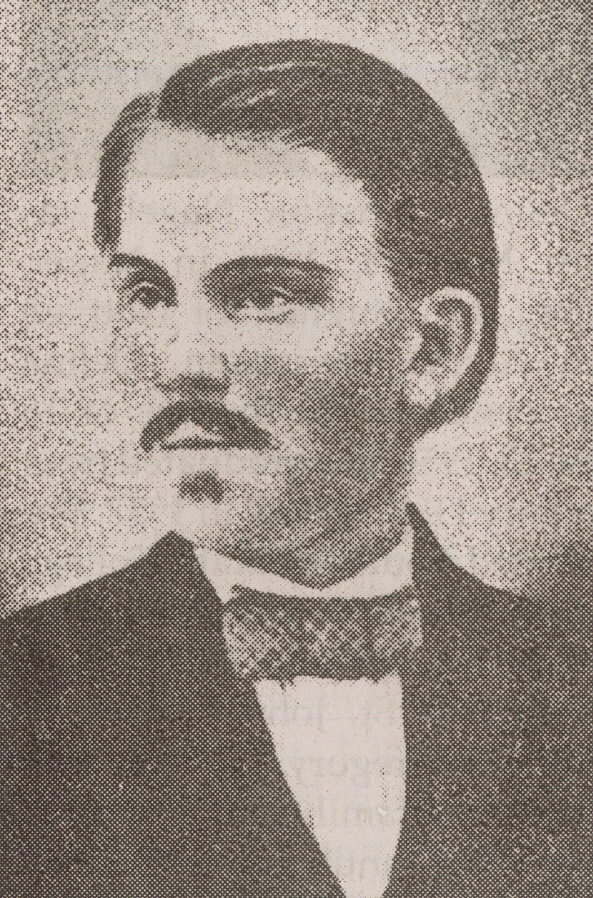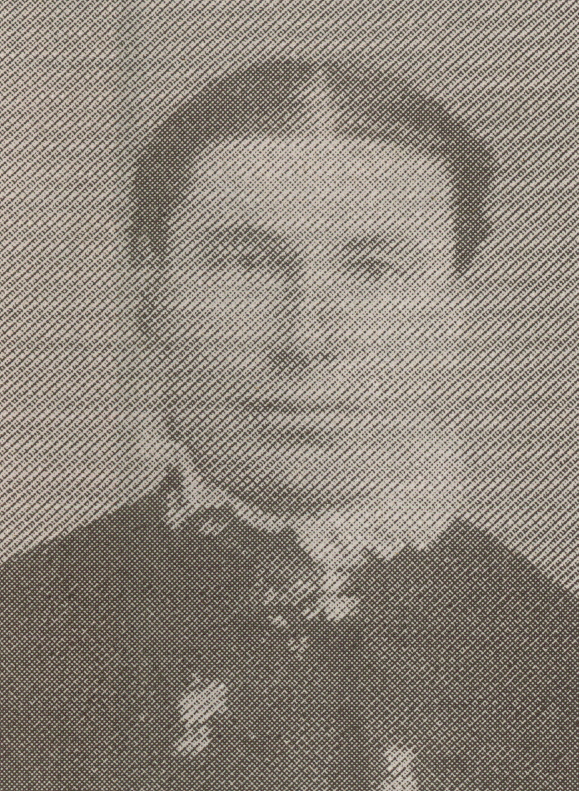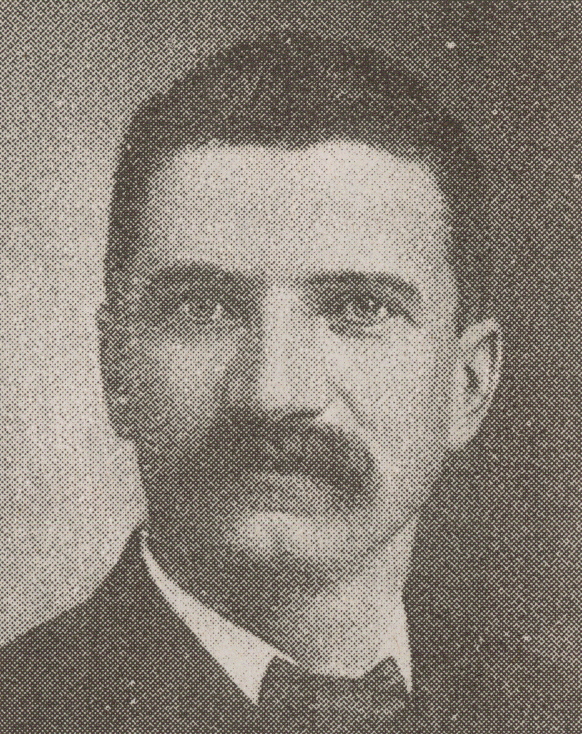

| search engine by freefind |
- Home Page
- Biographies
- Obituaries
- Marriages
- Queries
- Newspaper Clippings
- Photos
- Maps
- Local Contacts
- Online Resources
Bad Yankton County Farmer Boys Again in the Law's Grips
About two months ago two young men named Howe, sons of a wealthy and respectable farmer of Yankton county, were arrested upon the charge of wholesale harness stealing, the thefts being committed in the neighborhood of Tyndall, Bon Homme county. When arrested several sets of harness were found in their possession. The boys were then taken to Tyndall and lodged in jail. A few days ago they became tired of their confinement and broke jail. The want of money and the wish to get a team belonging to one of the brothers which had been kept in Yankton since their arrest, took them to that city. Sheriff Hickey was notified of their escape and the boys had not been in Yankton many hours ere he captured both. Sheriff Eads of Bon Homme county was notified of their recapture. When the boys were turned over to him he gave Sheriff Hickey $100 for their arrest.
Source: Dakota Farmers' Leader (Canton, South Dakota) ~ November 25, 1898
Ben and Dell Howe pleaded guilty to the charge of larceny of several sets of harness at Tyndall and were sentenced to the penitentiary at Sioux Falls for three years and a half.
Source: Dakota Farmers' Leader (Canton, South Dakota) ~ December 16, 1898
In Bon Homme county as Mrs. Patrick Curry was passing along the road she attacked by two savage dogs, each of which seized her by the arm, and in this way the brutes were dragging the woman about until help came. She was very badly bitten.
Source: Jamestown (North Dakota) Alert ~ December 23, 1881
A. J. Cogan has retired from the Scotland Citizen as its editor and publisher. The paper has passed into the hands of the Scotland Publishing Company.
Source: Jamestown (North Dakota) Alert ~ September 16, 1881
The Mennonites located three miles from Bon Homme are contemplating a removal to the Pacific slope. Agents sent out for the purpose have found desirable locations in Oregon, and report says that if they can dispose of their large estate they will remove at an early day.
Source: Jamestown (North Dakota) Weekly Alert ~ March 24, 1882

Source: Bismarck (North Dakota) Tribune ~ February 29, 1884
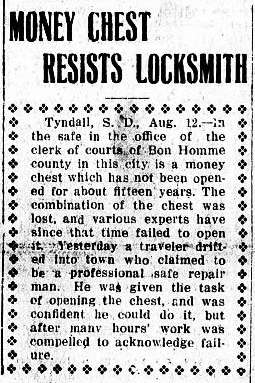
Source: Bismarck (North Dakota) Daily Tribune ~ August 13, 1913
Sioux Falls, Feb. 10 - Peter Zeeb, coming from Bon Homme county, is the first wife beater ever lodged in the Sioux Falls penitentiary. He has been turned over to the warden and will be required to serve one year at hard labor for the offense. Zeeb had been lodged in jail for beating his wife in their home in Scotland, when he decided to enter a plea of guilty to the charge of assault with a dangerous weapon. This he did before Judge Tripp of the state circuit court, who gave him the sentence stated.
Source: Bismarck (North Dakota) Daily Tribune ~ February 10, 1912
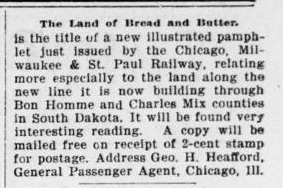
Source: The McCook (Nebraska) Tribune ~ January 19, 1900
Sioux Falls, SD, Aug. 14 - Three men from Des Moines, Ia., whose names have not been ascertained, had a costly experience in Bon Homme county with the South Dakota game law. They must have been unfamiliar with the provisions of the game laws of this state, which prohibits the killing of prairie chickens prior to September 1, and were caught in the act of shooting prairie chickens. They were arrested on the complaint of Henry Youngerman, game warden of Bon Homme county. Nine dead prairie chickens were found in their possession. The prisoners were taken before a justice, who imposed a fine of $10 for each bird and costs, aggregating $93.50. This is the heaviest fine imposed anywhere in the state thus far this season for shooting chickens out of season.
Source: Omaha (Nebraska) Daily Bee ~ August 15, 1904
Scotland, SD Journal: Hon Jos Leach and family of Running Water were here Tuesday on their way to the Pacific coast. On their way Mr Leach will stop off at Bismarck to visit two of his sons, and Mrs Leach will visit her people at Missoula, Mont. Mr Leach has shipped his goods to Billingham, Washington, but does not know until he gets there at what place he will locate. He has one son in business at Seattle, and will probably stop there for a time. Mr Leach has resided in Bon Homme county for twenty-seven years and we regret that he has decided to remove permanently from the county.
Source: Dakota County (Dakota City, Nebraska) Herald ~ August 13, 1909
In Cistern Mother Holds Boy Above Water for Two Hours
Sioux Falls, SD, Sept. 29 - By holding her little boy's head above water during two long and weary hours, and thus saving him from drowning, Mrs. William Mueller, a well known resident of Bon Homme county, exhibited rare heroism and placed herself in the Carnegie Hero Medal class. While playing around an open cistern the little boy fell through the opening into the water. The mother chanced to be near at hand and was a witness of the accident. When she saw him disappear into the cistern she without a moment's hesitation sprang after him. Grasping him she got his head above water and then screamed for assistance. Her screams were not heard by any passerby and not until her other children returned from school was her predicament discovered. Men then were summoned to the scene and they drew both mother and and child to the surface of the ground.
Source: The Norfolk (Nebraska) Weekly News ~ October 2, 1908
John Biesma from south of town met with an accident the other day with a rifle, which he loaded in the house in preparation of shooting rats on his farm. The telephone rang, and upon going to answer it with his finger on top of the mussel of the gun, he jarred it unconsciously up and down on the floor several times and the rifle discharged, tearing off one of his fingernails and other bruises to his finger.
Source: October 3, 1946
Of Captain Wagner, nominee for reelection to the next legislature from Bon Homme county, the Mitchell Republican says: "Capt. B. R. Wagner came to Dakota ten years ago from Foreston, Ill., and is engaged in stock raising and farming near Springfield, Bon Homme county. He was an old Army comrade of Governor Pierce, serving through the war in the Thirty-Fourth Illinois regiment and in the same department with the governor. Captain Wagner carries a bullet in his body from Shiloh. After he was disabled he was commissioned provost marshal by President Lincoln and given charge of prisoners of war at Rock Island, Ill. Captain Wagner is a brother-in-law of Congressman Hitt, of Illinois. He has long been one of the leading men of his county and represented Bon Homme in the last territorial assembly."
Source: Bismarck (North Dakota) Weekly Tribune ~ October 17, 1884
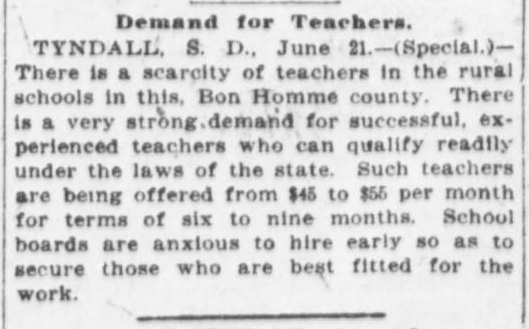
Source: Omaha (Nebraska) Daily Bee ~ June 22, 1909
Sioux Falls, SD, Mar. 9 - Rev. G. E. Brown of Mankato, Minn. who recently accepted a call to the pastorate of the Congregational churches at Tyndall, Running Water, and Perkins, situated in Bon Homme county, has notified the authorities of the three churches that he expects to reach South Dakota on March 18 for the purpose of assuming his new duties.
Source: Omaha (Nebraska) Daily Bee ~ March 10, 1908
Sioux Falls, SD, Sept. 15 - R. L. McIntosh, whose farm and ranch are situated near the old town of Bon Homme, has become the heaviest cattle dealer in Bon Homme county. He has shipped seventeen carloads since last spring and still has several hundred head. During the last year, he has shipped as many cattle as some of the stockmen on the great cattle ranges west of the Missouri River, showing what can be accomplished by diversified farming in the older settled region east of the river.
Source: Omaha (Nebraska) Daily Bee ~ September 16, 1902
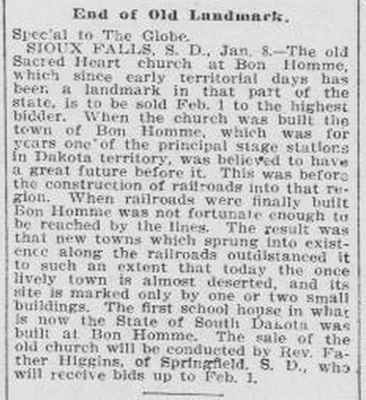
Source: The Saint Paul (Minnesota) Globe ~ January 9, 1902
Henry Dykstra, a well-to-do Hollander farmer living eight miles west of Springfield, says the Times of that place, is the originator of a variety of winter apple. It is of a larger size than the famous Wealthy apple, and a more hardy tree. Mr. Dykstra planted some apple seed thirteen years ago. It produced a lot of seedlings, most of which were too tender and have winter-killed. Two of his seedlings produced a crop of apples last season. One of them is a large and very handsome sweet apple of good quality, but the tree is not perfectly hardy. The other one is a very large and and showy apple, as large as the Spy apple, of a russetty-green color, round, stalk-long, set in a deep cavity, calyx closed in a large basin, flesh white, very firm, subacid with a brisk pleasant flavor, tree perfectly hardy, healthy, free and of an upright habit of growth, bark smooth and of a light gray color. In tree, bark, leaves and fruit, it is a full blood variety of the apple, there is no trace of crab blood in it: that is a great point in it's favor, as hybrids, like the Wealthy, are known to be short lived; another great point in its favor is its keeping quality. The apples are perfectly sound now, April 15, and by the looks of them they will keep two months yet, and perhaps longer. That point alone will make it the most profitable variety for market, as neither the Wealthy nor any of the Russian hybrids will keep longer then into January. But the greatest point in its favor is it's nativity; here in Bon Homme county it will succeed and flourish to a much greater perfection then further east or south. The name of Henry Dykstra will be remembered for generations to come as the successful originator of the first real hardy winter apple in the whole Northwest, and if planted largely it can be made of much more value for farmers in Bon Homme county than a rich gold mine. Peter C. De Linde, the veteran nurseryman of Running Water, Bon Homme county, Dakota, has bought the undivided right of Henry Dykstra to propagate and disseminate this local winter apple. He will graft it only on whole Siberian crab roots, that will induce early bearing and a more dwarfish habit of it's growth. This valuable winter apple has been named the Bon Homme County Winterapple, in honor of Bon Homme county, where it originated.
Source: St. Paul (Minnesota) Daily Globe ~ May 7, 1888
Bon Homme County - Originated by Hon. Henry Dykstra, Bon Homme County, S. D., from seed of Baldwin planted in 1874. According to Peter C. DeLinde, of Perkins, S.D., who introduced this variety and has an orchard of it in bearing, the tree is productive and the fruit keeps until June.
Source: A Study of Northwestern Apples by Niels Ebbesen Hansen ~ 1902
Scotland, SD - Michael Sew, one of the pioneer settlers of Bon Homme county, died last night of cancer. - A. E. Vandercook has sold his photograph gallery to Andrew Schmidt. - Charles Maxwell has sold his elevator to M. King of Utica.
Source: The Minneapolis (Minnesota) Journal ~ April 2, 1903
The Bon Homme County Independent is the name of a newly weekly newspaper which has just made its appearance at Tabor. W. A. Glasner, editor and publisher of the Springfield Times, is the managing editor of the new paper, which politically support the principles of the Democratic Party.
Tabor has a population of about 350, and is situated in the Southwestern part of Bon Homme county on the Platte branch of the Milwaukee railroad, in the heart of one of the richest agricultural sections of South Dakota.
One of the principal institutions at Tabor is a magnificent $35,000 Catholic college for girls. The new paper is the first newspaper to be established in the town.
Source: The Saint Paul (Minnesota) Globe ~ October 10, 1904
Posses are scouring the country in search of the men who looted the vaults of the Bank of Springfield Thursday morning and secured $5,400 in cash, and made their escape.
After the looting the bank the robbers fled in a rig stolen at Tyndall early Wednesday morning. The rig belonged to Dr. Greene of Avon, who was in Tyndall on professional business. From Avon they are believed to have gone south or east.
Officers in all the towns in that section are on the lookout for the highwaymen, and the authorities are very hopeful that they will be captured.
Cashier Hill, of the Bank of Springfield, said the bank's loss was fully covered by insurance. The bank is doing business as usual.
After gaining an entrance to the bank the robbers blew off the door of the vault with nitroglycerin. When they had forced an entrance into the vault, it was but the work of a few moments to blow the door off the safe, which contained the cash in the bank.
The reward of $250 for the arrest of each member of the gang has been increased to $1,000 for the gang or any part of it by the Bon Homme county officials.
Source: Dakota Farmers' Leader (Canton, SD) ~ October 13, 1905
Prize Prisoner at Sioux Falls Figures in Sensational Effort to Get Away
Sioux Falls, SD, July 14 - In attempting to make his escape from the state penitentiary late this afternoon, Fred Barton, the bank robber who is serving a term of fourteen years and six months, had a remarkably close race with death. The attempt to escape was a daring one and of an original character. Barton concealed himself in one of several bales of old rags which were being shipped from the penitentiary and was being conveyed to the Illinois Central freight depot. Had it not been for the fact that each bale was weighed when loaded he might have succeeded in making his escape.
However, when the bale in which he was concealed was weighed it was noticed that it was over a hundred pounds heavier than the other bales, and an investigation was made and Barton was found hidden in it.
Without being released from his uncomfortable position he was taken back to the penitentiary, and when the rags were withdrawn from about him, he was found to be nearly dead from suffocation and the severe jolting and tumbling to which he had been subjected when the bale was handled by the men in charge of it.
Barton, with other accomplices, "Jacko" Wilson, "Paddy" Carroll, and John Burns, was convicted last January in the circuit court of Bon Homme county of the robbery of the Bank of Springfield, in Springfield, in that county, on the morning of Oct. 5 last. The arrest of Barton and Burns was due to the vigilance of Chief of Police Zirbes of Aberdeen, who traced them to Sioux City.
They refused to return to South Dakota without the formality of requisition. This was secured by Sheriff Garner of Bon Homme county immediately before last Thanksgiving.
When arrested the prisoners had about $125 in silver which was identified as part of the Springfield plunder.
Source: The Minneapolis (Minnesota) Journal ~ July 15, 1906
They Will Start a Store Which Will Be the Only Business There
Sioux Falls, SD - June 4 - Two young women have patriotically come to the rescue and will prevent historic old town of Bon Homme from being wiped off the map.
A few weeks ago it was announced that as a result of selling of the store of A. J. Abbott at the aged town, on the Missouri river in Bon Homme county, that place, which was of importance in the early days of Dakota territory, had practically been wiped out of existence. At one time the town aspired to become the capital of Dakota territory. The construction of railroads into that part of the state left Bon Homme off to one side, and new towns springing up on all sides sounded the death knell of the old place. When Abbott sold his store, which for some time was the only business house in the town, it was supposed that the obliteration of Bon Homme had been completed, but now Misses Fenenga and Harrison have decided to resurrect the old town by establishing a new store.
Source: The Saint Paul (Minnesota) Globe ~ June 5, 1904

Source: Dakota Farmers' Leader (Canton, SD) ~ May 8, 1914
Source: Dakota Farmers' Leader (Canton, SD) ~ November 6, 1914
Joseph Nikodym, Jr., a farmer living near the little town of Tabor, was seriously wounded as the result of being accidentally shot by his hired man. The farmer was driving cattle out of his pasture when the hired man, who was duck hunting at a nearby lake, fired at some ducks.
Source: Dakota Farmers' Leader (Canton, SD) ~ June 29, 1906
To make a profit of $1,500 from a two weeks' investment in South Dakota farm land was the experience of a man named Kortans, who resides at the little town of Tabor, Bonhomme county. Two weeks ago he purchased a farm near the little town of Dante, in Charles Mix county. Now he has sold the land for $1,500 more then he paid for it, which makes a very good profit for the two weeks he held the land. This is believed to break all records in the history of the state, considering the short period he owned the farm and the great increase at which he sold it.
Source: Dakota Farmers' Leader (Canton, SD) ~ February 25, 1910
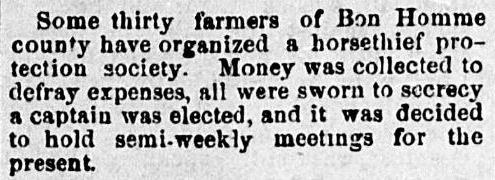
Source: The Canton (South Dakota) Advocate ~ April 15, 1880
It seems that Indian Agent Stevens of Crow Creek, a pioneer resident of Bon Homme county, and an honest man, a man of independence and courage, a man who will never play tool for any boss, is at present under fire by order of the Missouri river "Warwick." Stevens is a fighter and some of the machine bosses will understand his power before he gets through with them.
Source: Dakota Farmers' Leader (Canton, SD) ~ April 19, 1901
James Stephens of Springfield, a clean square-toed republican, an old-timer, a man who located in Bon Homme county thirty years ago, has been removed as Indian Agent at Crow Creek because he would not bow down and worship the machine. His place has been given to one Harry Chamberlain, of Faulk, a nice young machine oiler. The Indians will need protection from the Lord.
Source: Dakota Farmers' Leader (Canton, SD) ~ May 3, 1901
Over in the South Dakota Soldiers' Home, at Hot Springs, there resides one of those genuine old times, one of the few men who located in the territory of Dakota in 1858, three years before the territory was organized. His name is Thomas Tate, but everyone calls him Tom for short. Tom has been keeping his historical eye on the controversy concerning where and when the first school house was built in what is now South Dakota. Tom has a memory and has seen Dakota grow since 1858, when he located at the little village of Bon Homme in Bon Homme county. He has never cared to mix up in the school house dispute, hence his silence up to this time. Since Doane Robinson has discovered the :real thing," and made note of it in his Monthly Dakotan Tom concinded to tell about his connection with the erection of the first school house.
"In the summer of 1860," said Tom, "John Tallman and myself were employed by John H. Shober at Bon Homme, and one day Shober expressed a desire to build a school house if he could get the lumber from Sioux City."
"What's the matter with cottonwood logs?" I answered.
"Nothing. They're all right," replied Shober.
"Then, why can't John and I go over to Bon Homme Island and cut the logs and raft them across to the bank here?"
"That was the beginning of the matter. John Tallman and I were directed by Shober to go to the Island and cut the sufficient logs and raft them across the Missouri, and it was not hard to do, as the main channel of the river happened to be on the west side of the Island at the time."
"We cut the logs and got them across the river all right. John and I did most of the work in preparing the logs. The famous little log school house was 14x16, with rail and dirt roof. Of course the floor was constituent parts of good old mother earth. The building contained one sash with six 8x10 panes of glass. I did the plastering with a first class mud compound. The desk used by the children was made from a broken wagon box. Miss Emma Bradford was the first teacher. She was next to the oldest daughter of D. P. Bradford. The scholars were ten in number, and named George and Delia Rounds, John and Ella Bradford, Ann, Mary, George, and Joseph McDaniels, and I think the other two were children of a Mr. Irish just in from Minnesota. I afterwards married one of the scholars, Mary McDaniels."
"My partner in the erection of the school house, John Tallman, and myself both enlisted in Company A, Dakota Cavalry, commanded by Capt. Nelson Miner. While our company was in winter quarters at Vermillion 1864-65, Tallman went over into Nebraska to hunt. He did not return and in a few days we found his frozen body. I assisted in cutting the logs and putting up the also famous school house at Vermillion in 1865. The work was done by members of Capt. Miner's Company."
George Falkenburg, also a member of the Soldiers' Home, was one of the active men in the construction of the Vermillion school house.
Mr. Tate's contribution to the historical record is complete and ends all dispute concerning the erection of the first school house in what is now South Dakota.
Source: Dakota Farmers' Leader (Canton, SD) ~ April 19, 1901

Source: Dakota Farmers' Leader (Canton, SD) ~ April 24, 1914
Tyndall - C. J. Hatch, deputy food and drug commissioner, has been working in Bon Homme county, and as a result five farmers have been arrested and fined for selling bad eggs. In each instance the fine was $10 and costs. The commissioner discovered that in one of the cases the farmer had not only attempted to sell an Avon merchant a case of eggs in which there were fourteen stale eggs, but in which there were also several hard boiled eggs which evidently had been prepared for family use.
Source: Dakota Farmers' Leader (Canton, SD) ~ July 17, 1914
Mrs. G. Munger of Avon, has been visiting her parents, Mr. and Mrs. Sheldon. She left Monday for Chamberlain where she will make her home.
Source: Dakota Farmers' Leader (Canton, SD) ~ March 16, 1906
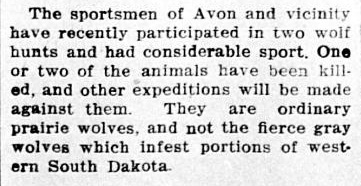
Source: Dakota Farmers Leader (Canton, SD) ~ November 17, 1911
Herman Walkes has just sold his quarter section homestead, adjoining Avon on the southeast, to Fred Wepking for $70 per acre.
Source: Dakota Farmers' Leader (Canton, SD) ~ August 7, 1908
The arrest of Lloyd Vaughters, a well known young man residing at Avon, on the charge of burglary, has created a sensation. This serious charge was preferred by the manager of the business establishment of Hagarty Drug company, of Avon. The accused will be tried during the next term of the state circuit court in Bon Homme county. The manager of the drug company had been aware for some time that the store was being burglarized, as nearly every morning evidences were found that someone had been in the store during the night. A few dollars in cash at times and often cigars and other property was missed. Suspicion fell upon Vaughters, who had formerly been employed in the drug store, and a watchman was employed to catch the burglar in the act if possible. The watchman remained inside of the building and had not been on duty long when, it is alleged, he caught Vaughters in the act of burglarizing the place.
Source: Dakota Farmers' Leader (Canton, SD) ~ July 12, 1907
We give an engraving herewith of the artesian well at Springfield, South Dakota, as it appears in operation. It is 592 feet deep, eight inches in diameter. The pressure of the water is sixty pounds to the square inch. By using the proper nozzles on the pipe it throws a solid stream eight inches in diameter 12.5 feet high, a six-inch stream twenty-six feet, a four-inch stream sixty-two feet high, a two-inche stream eighty-eight feet high. It furnishes power to drive a sixty-barrel flour mill, with a large surplus. Our engraving is from a photograph by Mr. B. W. Burnett, of Tyndall, South Dakota. A correspondent describes another well located near Aberdeen, South Dakota. It has a depth of over 1000 feet. The pipe is six inches and the pressure 150 pounds to the square inch. From it the owner expects to irrigate his farm of 800 acres. The supply of water appears permanent and bountiful, and if half the expectations of the people will be realized, a new era will dawn upon Dakota. Already a number of farms, level and well located, are watered by means of artesian wells, and give excellent results. Of course, all farms cannot be irrigated. A farm must be smooth and with a gentle slope, with the water at the highest point, in order to give the best results. Still, there are many such that could be made productive with abundant water.
Source: The Helena (Montana) Independent ~ 29 June 1891
On the tenth of this month, Reuben Groot, an old resident of Bon Homme county, celebrated his 88th birthday. Mr. Groot was born in New York state, has been in every state in the Union except one, came to South Dakota in the early eighties, and is today hale and hearty. Mr. Groot retired from the banking business a few years ago.
Source: Dakota Farmers' Leader (Canton, SD) ~ September 25, 1914
Paul McLane, who has conducted the Hotel d'Avon for the past two years, has discontinued the business and Avon is now without a hotel. Mr. McLane made a success in the hotel business, financially, but for other reasons he decided to quit it.
Source: Dakota Farmer' Leader (Canton, SD) ~ March 6, 1903
Louis Krall, game warden of Bon Homme county, and George Cox, a deputy, had an interesting experience as a result of running upon four young men living at Avon, who were out on the prairie with their guns and a couple of hunting dogs. Under the provisions of the state game law this alone was primafacie evidence that they contemplated violating the state game law. The game warden demanded the surrender of the dogs and guns, but the young men refused, declaring they were simply training their dogs preparatory to the opening of the shooting season.
The following day Sheriff McPherson went to Avon and arrested the young men. When taken before a justice at Tyndall they were fined $14 each, four prairie chickens having been found in their possession. Had the game warden so wished they could also have been punished for resisting an officer.
Not satisfied with having escaped so lightly, the young men, as an act of retaliation for their arrest, had the game warden and deputy arrested on the charge of having four prairie chickens in their possession. These, as near as could be learned, were the identical birds which the game warden had seized from the young men. Upon being taken before a justice, and the facts being stated, the cases against the game warden and deputy were dismissed. The two officers were arrested by the town marshal of Avon at 1 o'clock in the morning, and a justice was routed out of bed to hear the case at once. When the young men ascertained the seriousness of thus causing a game warden unnecessary annoyance because he had performed his duty, they were glad to drop the case.
Source: Dakota Farmers' Leader (Canton, SD) ~ September 9, 1904

Source: The Canton (South Dakota) Advocate ~ July 1, 1880
Capt. Joseph Leach of Running Water, will this year again engage in Missouri River traffic between points in Charles Mix and Gregory counties and Running Water. He has just completed extensive repairs on his steamer, the South Dakota, preparatory to commencing the season's business, which is expected to be an unusually profitable one.
Source: Dakota Farmers' Leader (Canton, SD) ~ April 12, 1901
Asa Hall, one of the active, pushing, successful farmers, was in town Saturday accompanied by his son, Charles of Running Water, and they favored this office with a call. Asa Hall has the fine half section farm of K. E. Jacobson rented and is making it "bloom" with wealth producing products. He can make money on any farm because he farms scientifically.
Charles Hall, foreman on the big 4000 acre ranch of I. W. Seamen at Running Water, was in Canton Saturday, after a three days visit in Norway Township with his parents and sisters. Charles is a genuine western boomer, one of kind that does things. He has already put in 400 acres of winter wheat and has 900 acres of fine corn to husk this fall, and the cattle interests of the big ranch are enormous. Mr. Hall is well fitted to keep everything moving on the ranch because he is a hustler by nature and is big and strong and active and might be properly termed an agricultural engineer. He returned to Running Water Saturday.
Source: Dakota Farmers' Leader (Canton, SD) ~ September 18, 1908
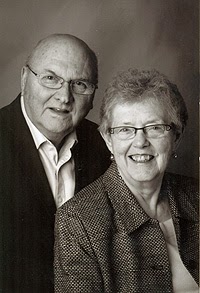
Charles and Alberta Bender are set to receive Honorary Doctorates from Mount Marty College during the 2014 spring commencement exercises at 2:00 p.m. Saturday, May 10, 2014 in Laddie E. Cimpl Arena, Yankton.
Charles Bender was born in St. Helena, Nebraska, and graduated from Holy Trinity High School, now Cedar Catholic High School in 1953. He entered the U.S. Army where he served from 1956 to 1958. After his time with the Army he served as a member of the South Dakota Army National Guard from 1958 to 1961. In 1959 Charles started as a laborer for the Welfl Construction Company. During his time with Welfl Construction, Charles worked on the construction of the Sacred Heart Monastery in 1959, the addition to Sacred Heart Hospital in 1965, the concrete structure of the current Sacred Heart Hospital, Whitby Hall, Corby Hall, and the Old Library building. In 1991 he became an owning partner and president of Welfl Construction, while owner projects included the remodel and addition to the Sacred Heart Monastery, St. Scholastica building and remodel of the Roncalli Center.
Charles' service to others is without question. He has participated in job fairs at both the Yankton Federal Prison Camp and Springfield State Prison where he helped inmates practice interviewing skills so that they may gain employment. He has been a member of the VFW since 1958, the Knights of Columbus since 1968, and the Elks since 1971. He was a member of the Mount Marty College Board of Trustees from 1994 to 1999, Crofton Golf Course Board member from 2000 to 2005, and currently serves on the Mount Marty College Buildings and Grounds Committee.
Alberta Bender was born in Avon, South Dakota and graduated from Avon High School. After graduation she started work at the Tyndall Clinic as a receptionist/clerk from 1955 to 1964. Alberta's sense of service to others and volunteering can be seen by everyone. She has been a member of the Catholic Daughters since the 1970's where she served as the financial secretary. She has also served as a 4-H Mother and volunteer since the 1970's, and from 1976 to 1978 she was a Den Mother for the Cub Scouts. She volunteered at the State Hospital Library from 1992 to 2006 and currently she is employed at the Natural Resource Conservation Service where she started as a volunteer in 1992.
Charles and Alberta just celebrated their 50th Wedding Anniversary on April 4 and are the parents to five wonderful children; Delaine, Sharla, Gale, Chris, and Kevin. They have been heavily involved at both Sacred Heart and St. Benedict Catholic Churches and significant donors and supporters of the Catholic Education System.
Source: Mount Marty News Release
Mrs. Sarah Carda, an aged resident of Tabor, was badly hurt when she was attacked by a vicious cow. The woman was knocked down and severely trampled before she could be rescued.
Source: Dakota Farmers' Leader (Canton, SD) ~ May 17, 1912
Joseph Oreberg, sheriff of Meade County, situated in the extreme western part of the state, swooped down on the little town of Tabor, in the extreme southeastern part of the state, and took into custody Daniel Bates, who is accused of having robbed a homesteader in Meade county of $135 in cash.
The crime is alleged to have been committed last winter. It is charged that Bates entered the car in which the homesteader was riding with his effects, and that he attacked him and forcibly took the money. Bates and his wife took up residence at Tabor only three weeks ago and Bates entered the employ of the Milwaukee Railway company.
The accused, who readily consented to accompany Sheriff Oreberg, before his departure stated that it was a case of mistaken identity and expressed the belief that he would have little difficulty in establishing his innocence of the serious charges against him, which constitutes a penitentiary offense.
Source: Dakota Farmers' Leader (Canton, SD) ~ May 27, 1910
A stranger entered the saloon of Matt Reidinger at Tyndall and requested the proprietor to change a bill. The saloon keeper took from his pocket a roll of bills. The stranger grabbed the money and ran. The amount taken was $160.
Source: Dakota Farmers' Leader (Canton, SD) ~ February 15, 1901
John Pesek, living near Tyndall, met with a painful accident while working in his blacksmith shop. He is subject to epileptic fits, and while working at his forge was taken with one and fell with his face in the fire, where he remained until discovered fifteen minutes later. His recovery is doubtful.
Source: Dakota Farmers' Leader (Canton, SD) ~ October 08, 1897
The Tyndall Tribune says N. M. McDuffie, the granger school master who rented the Dunlap farm near Bon Homme, skipped the country this week. He mortgaged about fifty head of stock belonging to Mr. Dunlap for $825 and left with his family for parts unknown.
Source: The Canton (SD) Advocate ~ September 04, 1884
Source: The Canton (SD) Advocate ~ February 17, 1881
The twelve-year-old daughter of Mr. and Mrs. Joseph Pobunda, Sr., well known residents of the little town of Tabor, recently proved herself a heroine of no small degree by rescuing a four-year-old girl from drowning. The little girl with some playmate had been playing on the bank of a creek which flows through Tabor, when she lost her balance and fell into the stream. The Pobunda girl plunged into the swollen stream and went to the rescue of the child, and after some effort succeeded in bringing her safely to shore.
Source: Dakota Farmer's Leader (Canton, SD) ~ August 6, 1909
Presidential Electors - Henry P. Lason, of Tyndall, Bon Homme county is a splendid specimen of manhood, erect and manly in every line. He was a private in Co. "F," 76th New York Infantry, as an evidence that he stood by his country in the hour of its peril, as he is now doing, he carries an empty sleeve, and one of his good arms lies buried in the south.
Source: Dakota farmers' leader. (Canton, S.D.) ~ 24 July 1896
Badly Injured by Accidental Discharge of a Gun
A Tyndall special says: Enos, son of Dave Greeting, county commissioner, was shot by the accidental discharge of a gun while hunting prairie chickens. He was brought to Tyndall, where the wound was dressed by Dr. W. E. Moore. The young man lost the larger part of one hand and part of one of the bones of the forearm.
Source: Dakota Farmers' Leader (Canton, SD) ~ September 26, 1902
Diphtheria broke out in the family of J. L. White at Tyndall. The house was quarantined and there are no fears of the disease spreading. The patient is recovering.
Source: Dakota Farmers' Leader (Canton, SD) ~ November 07, 1902
Source: Dakota Farmers' Leader (Canton, SD) ~ April 18, 1902
Source: The Saint Paul (Minnesota) Globe ~ March 10, 1902
Source: Bismarck (North Dakota) Daily Tribune ~ May 5, 1904
Source: The Minneapolis (Minnesota) Journal ~ March 20, 1902
And Seeing Way Out, They Sawed to Liberty
Source: The Norfolk (Nebraska) Weekly News-Journal ~ April 27, 1906
Thrown from a hayrake by runaway horses, Miss Rose Sykora, daughter of Mr. and Mrs. Frank Sykora, who reside on a farm in Bon Homme County, South Dakota, had most of her hair torn out by the roots.
Source: The Alliance (Nebraska) Herald ~ August 31, 1911
M. H. Bardwell, has been entertaining a brother from Scotland, South Dakota, whom he met for the first time in 23 years, while at the Grand Army encampment in Boston last week. The two brothers suffered the horrors of prison life together 14 months, during the Civil War.
Source: Vermont Phoenix (Brattleboro, Vermont) ~ August 26, 1904
Yankton, S.D., Nov. 8 - The bank of Scotland, South Dakota was robbed last night of $5,000. The safe was blown up and the entire contents carried away.
Source: Rock Island (Illinois) Argus ~ November 8, 1901
Bouska of Tabor Gets a Letter
Told to Leave in Two Weeks Or Alleged Delinquencies Will Be Shown Up
Tabor, S.D., April 28 - Very Rev. E. A. Bouska, rector of St. Wenceslaus Catholic Church here, thinks there is a systematic effort being made to get him out of the community. The following anonymous letter was received by him:
We give you two weeks to get out of Tabor and out of South Dakota. If you do not go we will put your case in the papers, as Father Kelley and Father Biley was in. It don't matter that Dr. Ross has let up on you. We have proofs of your assault on his wife, and we will get it into the papers. - A. Committee.
Father Bouska does not intend to pay any attention to this threat, except to try and ascertain who his enemies are.
Some of the church people here say the German element is antagonistic to the priest and want one of their own nationality. Father Bouska makes no charges against anyone.
Source: The Minneapolis (Minnesota) Journal ~ April 28, 1902
Charged With Misapplying Bank's Funds
Chicago, April 23. Charles C. King president of the First National Bank of Scotland, South Dakota, was arrested here today by United States marshals.
He was recently indicted by the federal grand jury in South Dakota charged with having misapplied the funds of the bank and having issued certificates of deposit in his own favor amounting to forty-five thousand dollars.
Source: The Daily (Ardmore, Oklahoma) Ardmoreite ~ 23 April 1907
Four gentlemen from Springfield, S.D., were in the city this noon. They are taking a trip through the country on their bicycles. Their route passed through Running Water, South Dakota, where they crossed the river, then through Knox and Pierce counties to this city. From here they will proceed south to Monroe and thence east to Omaha where they will cross into Iowa. They will ride through that state as far as Des Moines and then will return home to Springfield. The names of the gentlemen composing the party are H. M. Davison, W. G. Mead, H. J. Hill, and R. G. Stevens. They compose a jolly quartet and are extracting much pleasure from their outing.
Source: The Norfolk (Nebraska) Weekly News ~ July 20, 1899
Tyndall - The boarding house of H. Goepfert was raided and four women and three men were taken to jail, among them Goepfert himself.
Source: The Minneapolis (Minnesota) Journal ~ 07 June 1901
Source: The Minneapolis (Minnesota) Journal ~ September 23, 1906
Although Carl and Sally Propeck have operated Propeck's Fish Haven at the Springfield Boat Basin here for five years (this is their sixth), they're planning a "grand opening" for Saturday and Sunday, July 28 - 29. Actually the "grand opening" pertains only to the fine, new air- conditioned dining rooms which have been completed at the Fish Haven, but the Propecks are inviting everyone to inspect the facilities of this popular "stopping off place" on Lewis and Clark Lake. Springfield is the only city on Lewis and Clark lake — the giant man made lake which stretches behind the Gavins Point Dam west of Yankton. The Springfield Boat Basin is regarded as one of the finest on the lake. In addition to the commercial operation of the Propecks at the Basin, there is a public swimming area, there are picnic areas and public toilets and bathhouse facilities. In addition to their restaurant facilities, the Propecks provide boat storage and service as well as penne.
Source: The Daily Republic (Mitchell, South Dakota) ~ July 25, 1962
Washington, July 30 - Marine casualties number four; Army casualties number 145, including killed in action Sergt. Grant Barber of Greybull, Wyoming; wounded severely, Frank Pavel of Tyndall, South Dakota.
Source: The (Carlsbad, New Mexico) Evening Current ~ July 30, 1918
Jesse Hendricks In Jail at Tyndall, South Dakota
Tyndall , S.D., June 26. As a result of the death of Mrs. Jesse Hendricks at Running Water on Sunday, May 30, the husband was arrested while passing through this city and will be tried upon the charge of murder. The arrest was made by Sheriff Kelley upon a warrant sworn out by Charles Haskins, of Running Water.
At the coroner's inquest, held immediately following the death of the unfortunate woman, a verdict of suicide was returned. A number of the residents of Running Water were dissatisfied with the finding of the jury, claiming that there was enough circumstantial evidence to warrant the arrest of the husband. The community where the death took place seem divided in the matter, there being some who refuse to believe In the murder theory.
Source: The Norfolk (Nebraska) Weekly News-Journal ~ July 02, 1909
Source: History of South Dakota ~ 1904
Source: St. Paul (MN) Daily Globe ~ Jan. 17, 1888
List of fatalities due to the blizzard in Bon Homme County
Source: St. Paul (MN) Daily Globe ~ Feb. 25, 1888
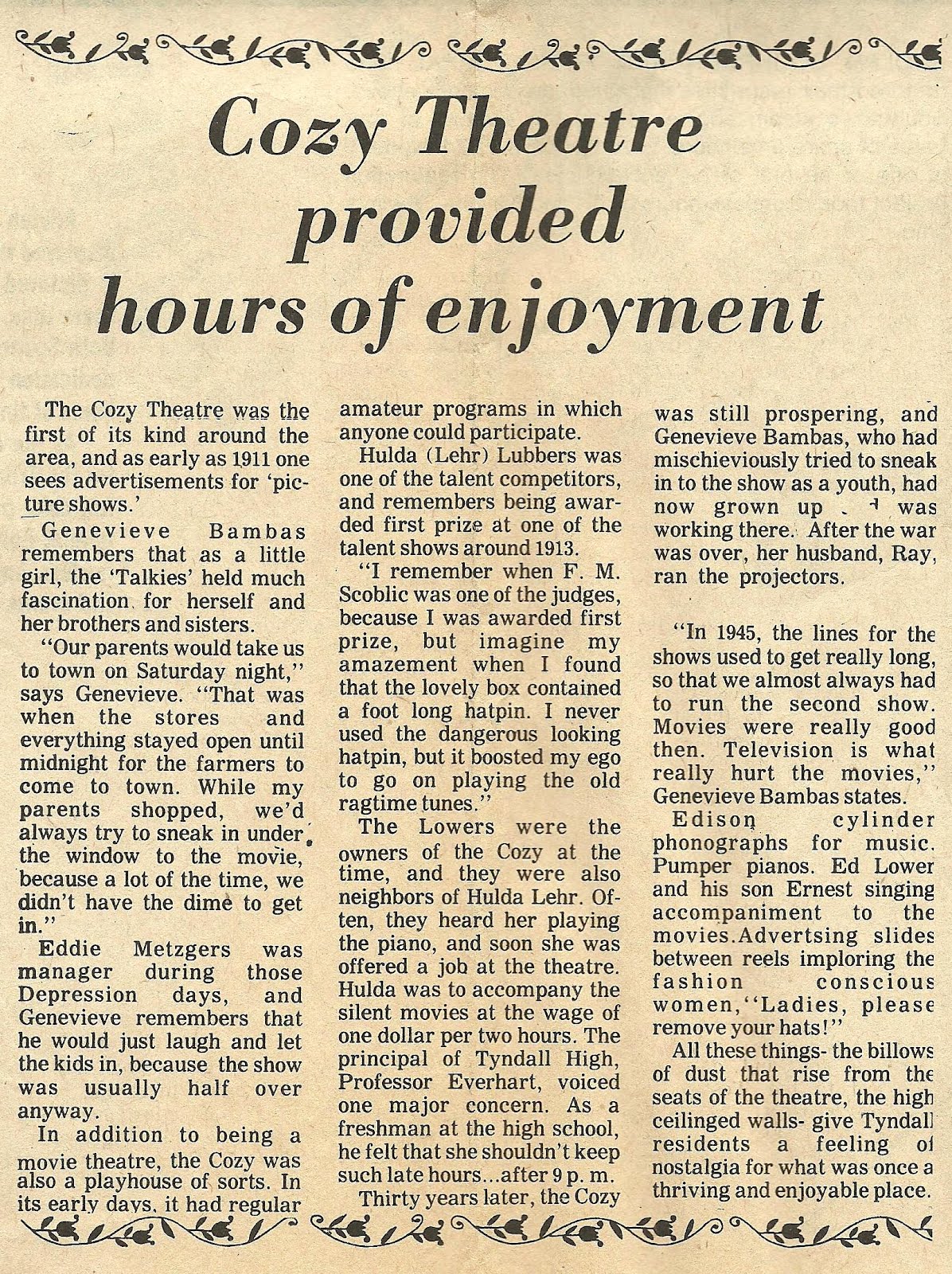
Genevieve Bambas, Eddie Metzgers, Hulda Lehr Lubbers,
F.M. Scoblic, Ed Lower, Ernest Lower, Ray Bambas
Source: The Tyndall Tribune & Register ~ July 5, 1979
Two paramount essentials the traveling public demands in a hotel. These are cleanliness and comfort. Both of these are specialties of Barber Tavern at Tyndall, operated by L F Barber, who is the son of a pioneer, the late D W Barber, and for years a practicing veterinary surgeon here in partnership with his brother, Dr J L Barber, who continues ths practice. Mr and Mrs Barber took over the ownership and mangement of the hotel April 1, 1928 and it has flourished under their careful direction. L F Barber was born and reared in Tyndall.
Barber Tavern affords 28 guest rooms, each airy and well lighted and each supplied with hot and cold water. Walls are tastefully decorated and hung with restful pictures that add to the atmosphere of homelikenes. Linoleums and rugs cover the floors and nothing is lacking that might complete the guests comfort.
Barber Tavern's main lobby is spacious and well appointed with every facility for writing and lounging and from this lobby to the furthermost room it is a delightfully clean and sanitary place. Its beds are spread with spotlessly white linen and are invitingly soft and comfortable."
Barber Tavern is indeed a valuable asset to the city of Tyndall.
Source: Evening Republican ~ November 18, 1929
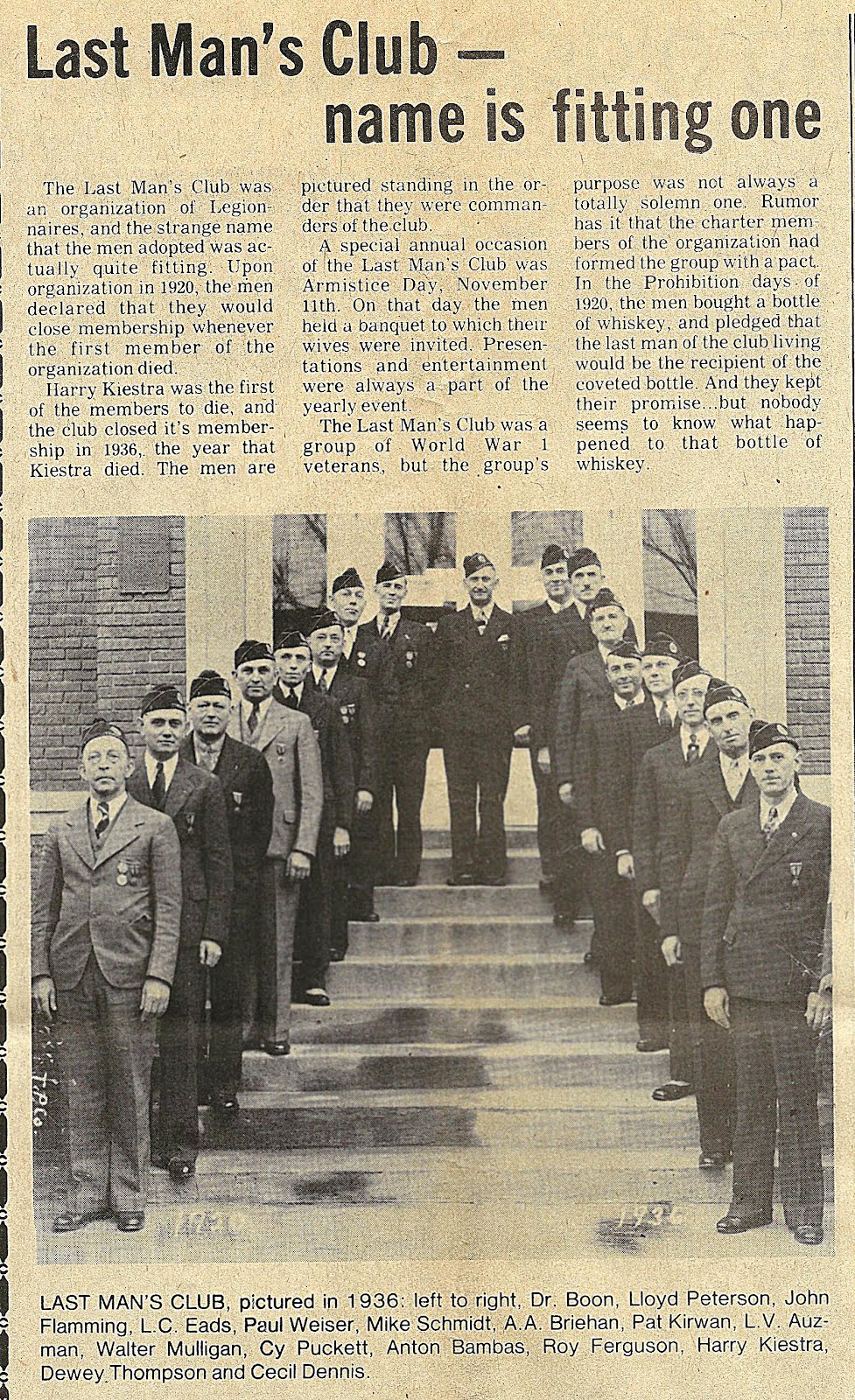

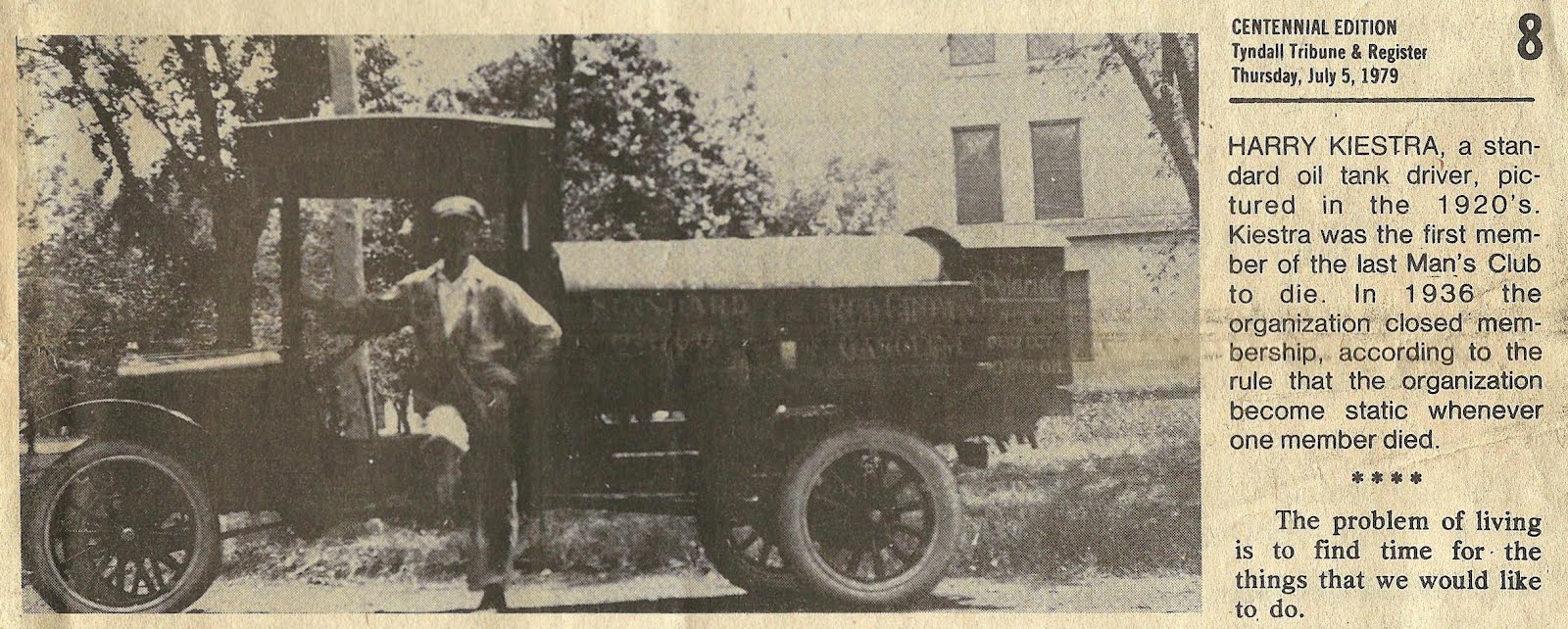
Kiestra, Boon, Peterson, Flamming, Eads, Weiser, Schmidt, Briehan,
Kirwan, Auzman, Mulligan, Puckett, Bambas, Ferguson,
Thompson, Dennis, Schanel, Osmond
Source: The Tyndall Tribune & Register ~ July 5, 1979
Area mechanical whiz turns lifelong interest into hobby

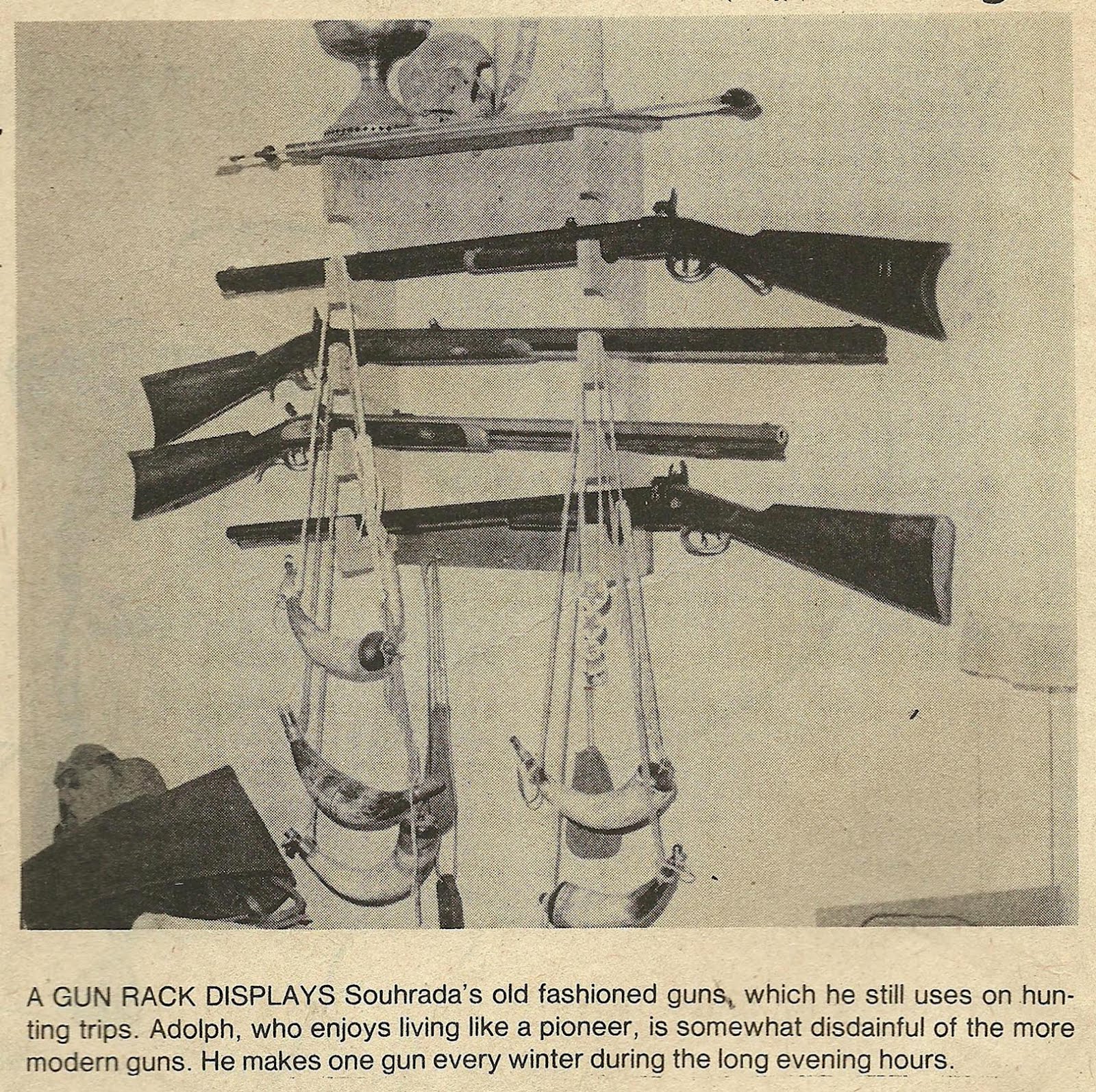
"I was born 150 years too late," says 69 year old Adolph Souhrada. "I've always liked to make things since I was a little kid."
His hobby has extended into his adulthood. Souhrada includes among his creations a steam engine, which he says he worked on for four years in his spare time, beginning in 1964.
Walking into the yard where the steam engine is displayed, the blue jeaned Souhrada indicates the wheels of the steam engine. "See these? They're from a threshing machine."
Souhrada raps the black iron. "I got the iron when I decided to build the engine and then had a man roll it," he says. "It's really just made of a lot of junk I picked up here and there. I read a lot about steam engines before I built this one, but mostly I just picked it up from being around this sort of thing all my life."
Souhrada says he first displayed an interest in how things worked early in his youth. "We used to have one of those old record players ... you know, the kind with the big old horn sticking out of the top of it? One day, my parents left and I was alone. I was only about ten then, I guess. Anyway, I started looking at that record player and trying to figure out how it worked. I took the whole thing apart, and put it back together again. My parents never knew."
Although Adolph displayed an early interest in mechanics, his ambition was never equally distributed in the academic area. "I hated school. I went to three schools in my lifetime. They all burned down. That's the only thing that ever got me from grade to grade," he chuckles. "I was the worst hooky player in the county."
Souhrada has always lived in the Tyndall-Tabor area. "I was born on a farm near Tabor and we moved to Tyndall when I was ten," he says. "We bought this farm in 1926. I always farmed the land because my parents were getting kind of old."
Souhrada remembers the Depression vividly. "I was farming this land and I just couldn't get anywhere. Those times were so rough. But people seemed to be pretty happy then. We really tried to help each other out. We were all equal. We were all broke!"
Souhrada continued to farm until the mid-40s, when he was called to war. "I was 32 then, but I was single. I suppose I wouldn't have been called if I had been married."
Souhrada returned three-and-a-half years later with a bad case of wanderlust, so he and friend took off for the South. Failing to find work, he returned home to farm and also to take care of his aging parents. Adolph started to work for International Harvester in 1948. "I walked in there one day and Jake asked me if I'd like to help him out for a few months," said Adolph. "I said sure. I retired in 1973."
During those years Souhrada had an opportunity to utilize his love of mechanics. During the 25 year span his parents also died; his father in 1958 and his mother in 1971.
Souhrada sits at the kitchen table in the house that he has called home for more than fifty years. "I could never leave here, though," he says seriously. "I figure I'll live here until I'm ready to go to some apartment. It's all right just for me ... what wife would ever put up with this?" He jokes now, indicating the obviously bachelor-like surroundings. "I'm not much of a housekeeper, I'm afraid."
"I kind of like living life a pioneer," Adolph continues. "I like to cut wood for my stove and the wood burning furnace." He indicated a huge pile of wood outside the window.
"See that machine beside it? That's a wood splitter. I made it myself. I'd cut down dead trees and the wood was too wide to split, so I worked on a machine. I was either getting lazy or modern, I don't know which."
Souhrada points now to the wall beside the window. "I make guns too. One every winter. Those are the kind that you have to pour the powder into yourself. Just like the old days. There's no shells to be put in or anything ... that's too easy."
Souhrada like to hunt and takes several trips a year. Some are with friends to the Black Hills and other areas. But the trip that Adolph enjoys most is always a solo venture.
"There's a place about sixty five miles from here that I like to go. I camp there and the prairie dogs howl and the wind blows. I like wide open spaces. It's quiet and serene. Just Mother Nature and me."
Source: The Tyndall Tribune & Register ~ July 5, 1979
Her 34 Year Occupation? Gravedigger.
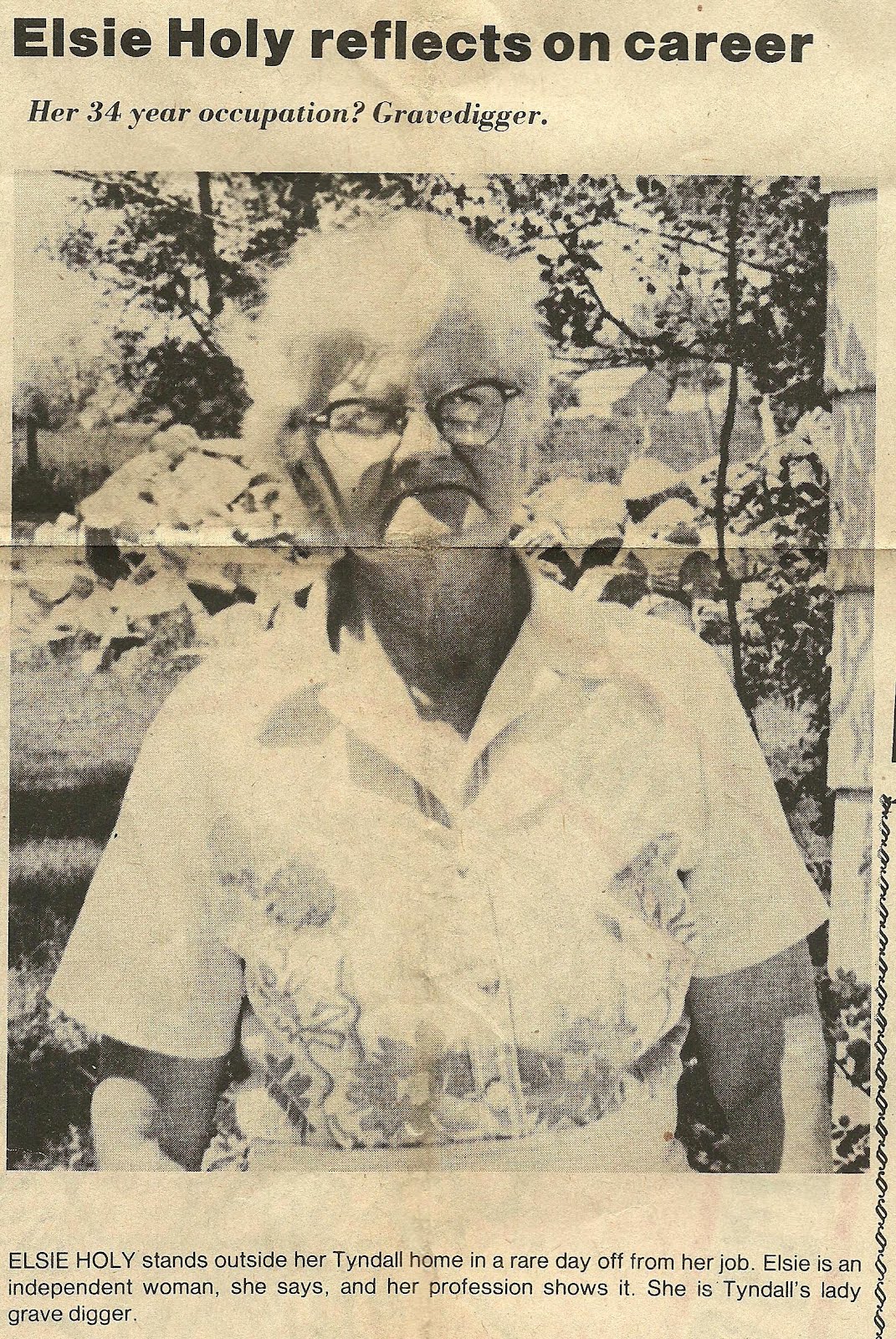
"I love to work; I've always liked to have a lot to do," says Elsie Holy. Her domestic appearance as she stands in the doorway in a pink gingham apron leads one to believe that she speaks of housework.
Elsie Holy doesn't. She is by profession, a gravedigger.
Mrs. Holy has had a variety of interesting jobs to her credit, but has been helping dig graves since she was 32.
"I helped my father when he used to do it," Elsie says. "He was getting pretty old then when we moved back."
She refers to the World War II years when she and her husband, Joe, moved to California. Prior to the move to the West Coast she and Joe and always lived in the area. Elsie grew up on a farm near Scotland and Joe was born in Tyndall. Following their marriage in 1932 they farmed Joe's father's land.
Ten years after their marriage "we just decided to move," says Elsie matter-of-factly. The Holys, who by now had a son and daughter, moved to the West Coast, where Elsie was a welder from 1942 to 1946.
"Then we just wanted to go home," Elsie relates. California seemed to capture one of the Holys interest, though. Elsie's daughter, now May Schaffer, is a mother of two and lives in Santa Rosa. Their son, Jim, has followed in his mother's footsteps and is a gravedigger in the Yankton cemetery. Jim and his wife, Sharon, have three children.
"I go over and help him out sometimes," says Elsie. Since Elsie is responsible for several of the towns surrounding Tyndall, the sites that she and Jim take care of often overlap.
"If everything goes well it usually takes about two hours to dig a grave," Elsie says. She tells of times that things haven't gone so well, though. Elsie recalls a few instances, one in which she was to have a grave dug by eleven a.m. on a very cold Thursday and wasn't informed until 4 p.m. Wednesday.
"You see, when the ground is that cold, you have to use a thawer," Elsie explains. A thawer, Elsie states, does just what the name indicates. It makes the ground suitable for digging.
Methods of digging have been modernized somewhat since Elsie and her father began. "We used to have to do everything by hand," Elsie says. "We chopped the ground away piece by piece until we got deep enough. Now we use a Bobcat."
Elsie Holy is convinced that the theory that women can withstand more cold than men is true. "A lot of the time in the winter we'll be out there and the men will be freezing. I keep moving, so I never get cold. They'll say, "What are you made out of, woman?"
Elsie guards herself against the cold, though. On a typical winter day that she has to go out and dig a grave, her outfit consists of a pair of thermal underwear, three pairs of jeans, three pairs of socks, two pairs of mittens, a pair of socks and a pair of overshoes.
The funniest thing that every happened to Elsie as a result of her profession occurred last spring.
"I had jury duty," she explains. "During that week I got a call to come and dig a grave, so I had to get off jury duty. So I went to the attorney and he said, 'Okay, Elsie, let's go for a ride.' So we went to the courthouse and saw the judge. The attorney told him why I couldn't be there; that digging graves was the way that I earn my living."
"The judge took one look at me and said, 'Dig graves? Why, she couldn't lift a dustpan!"
"The attorney said, 'Wanna bet?"
Source: Tyndall Tribune & Register ~ July 5, 1979
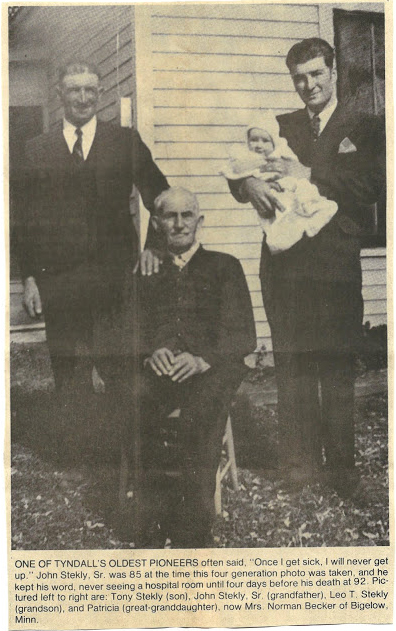
Four generations of the Stekly family are pictured in this photo, which was taken in 1941. John Stekly Sr. is seated, and was one of the original settlers of Bon Homme County. He came to South Dakota at 15 by covered wagon drawn by oxen. Stekly and his family had immigrated from Czechoslovakia.
Leo T. Stekly of Tyndall stands on the right of the photo, holding his daughter, Patricia. Leo remembers, "Grandpa used to tell us stories of the first years of homesteading. I suppose that during the first winter they roughed it, because he remembers that they lived in a dugout for a few years after they first came here."
Homesteading was indeed a test of survival for the Steklys in 1871, because at the time they settled two miles north of Tyndall, the town wasn't in existance.
"Grandpa often told of having to walk 28 miles to Yankton for a sack of flour," says Leo. "He used to tell us about building their first home. They had to walk to the river by Springfield and get material from the cottonwood trees on the shore."
That same house was the scene of the stories that Leo's father, Tony, told his children. Tony Stekly used to speak of the days when the ceiling of the house that his father built consisted simply of rafters with shingles on top. "Dad used to say that when it snowed, he'd often wake up with snow that had come through the roof of the house," said Leo.
The homestead staying the family for nearly a century. John Stekly Sr. farmed the land from 1871 to 1908, and moved into Tyndall in the fall of that same year. His son, Tony, then took over the farm, and lived on the homestead two miles north of Tyndall until 1945.
Leo Stekly began farming in 1945 when his father, Tony, retired and moved to town. The former Standard Oil station manager kept the farm until 1960, when he moved back to Tyndall.
Source: Tyndall Tribune & Register ~ July 5, 1979

Charles Bambas

Mechanics has been a hobby of Fred Koupal's since his teenage years, and has led to a lot of things, among them a full time preoccupation with collecting and renovation antique cars.
Fred even met his wife, Thelma, as a result of his mechanical aptitude.
"I grew up on a farm near Dante," says Fred. "One day my dad and I went into Farmer's Union to get a socket wrench to fix some farm equipment. Thelma was the bookkeeper there and I saw her and boom ... boom ... boom ..." He pounds his heart for emphasis as his wife enters the room, laughing at her husband's antics.
Thelma Koupal, a Home Economics teacher, found her domestic talents to be an asset when her husband first started getting involved in antique cars. She spent winter evenings helping him upholster the insides of his cars. "I never knew it would lead to this, though ...," she smiles.
"Well, you get started with one car and then have to go all over the country and find another car like it for parts," Fred rationalizes.
Fred tells the story of how the Koupals acquired their first antique car. "It was the '28 Dodge," he recalls with amusement. "Thelma was driving the front car and pulling me in the Dodge. The wheel was almost rotting off and it was rattling like crazy. I was afraid that it was going to fall off so I'd wave to Thelma to slow down. She though that I was being cute, so she'd wave back and go a little faster. I'd do it again and again, and she'd wave back and go a little faster. We made it, but I was in a cold sweat by the time we got through that 15 mile trip," he grins.
Thelma laughs as she recalls the incident. "I've improved only slightly since then," she says. "He usually gets someone else to pull him now, I'm the last resort only when he's terribly desperate." Thelma adds that now she sticks to upholstering the insides of the antique cars.
Koupal tells another story of the days in 1966 when he and Thelma were teaching in Howard. Koupal taught Industrial Arts and he and a fellow instructor discovered that they had one thing in common besides education. They were both "antique car nuts."
One Saturday they decided to go out scouting for cars and Koupal bought one in the process. "This was another 15 mile trip and he was pulling," says Fred. "He decided to have a little fun with this ride."
Fred adds now that the two teachers had bought the car from a farmer who had left it behind the barn, forgotten. "Chickens had roosted on the floor and under the seat," Fred recalls.
"As soon as we started driving, that chicken stuff started blowing up on me," Fred chuckles at the memory. "I'd look up to the car in front of me and my friend would look in the rear view, smile, and drive a little faster. Now all of it was coming up, and I'd look up there and he'd be laughing his head off. I didn't think it was THAT funny, but then we got back finally and I realized what was so hysterical. The only thing white on me was my eyeballs. Otherwise, I was black head to toe."
The Koupals moved to Tyndall twelve years ago. "I started with Moormans then and quit teaching," says Fred. He is a feed salesman now and Thelma teaches at the high school. The Koupals have two children, Sandy, 13 and Keith, 10.
Fred Koupal bought his first antique car fourteen years ago, shortly before Sandy was born. "It can be very frustrating at times, but most of the time it's a real challenge," says Fred.
Koupal spends 'thousands and thousands' of hours getting his cars into running order. "I really like to do body work more than anything," he says. "But I don't mind getting the engine into shape either," he adds.
Fred's biggest project these days is getting the '28 Dodge driving. The '24 Model A will be the car he drives this week in the parade.
"There's one advantage to these cars. They'll run on alcohol. If we ever run out of gas, I can pour a quart of vodka into this things, and with a few modifications, I can have wheels."
Source: Tyndall Tribune & Register ~ July 5, 1979
Tyndall teacher is Centennial book writer; Pageant director
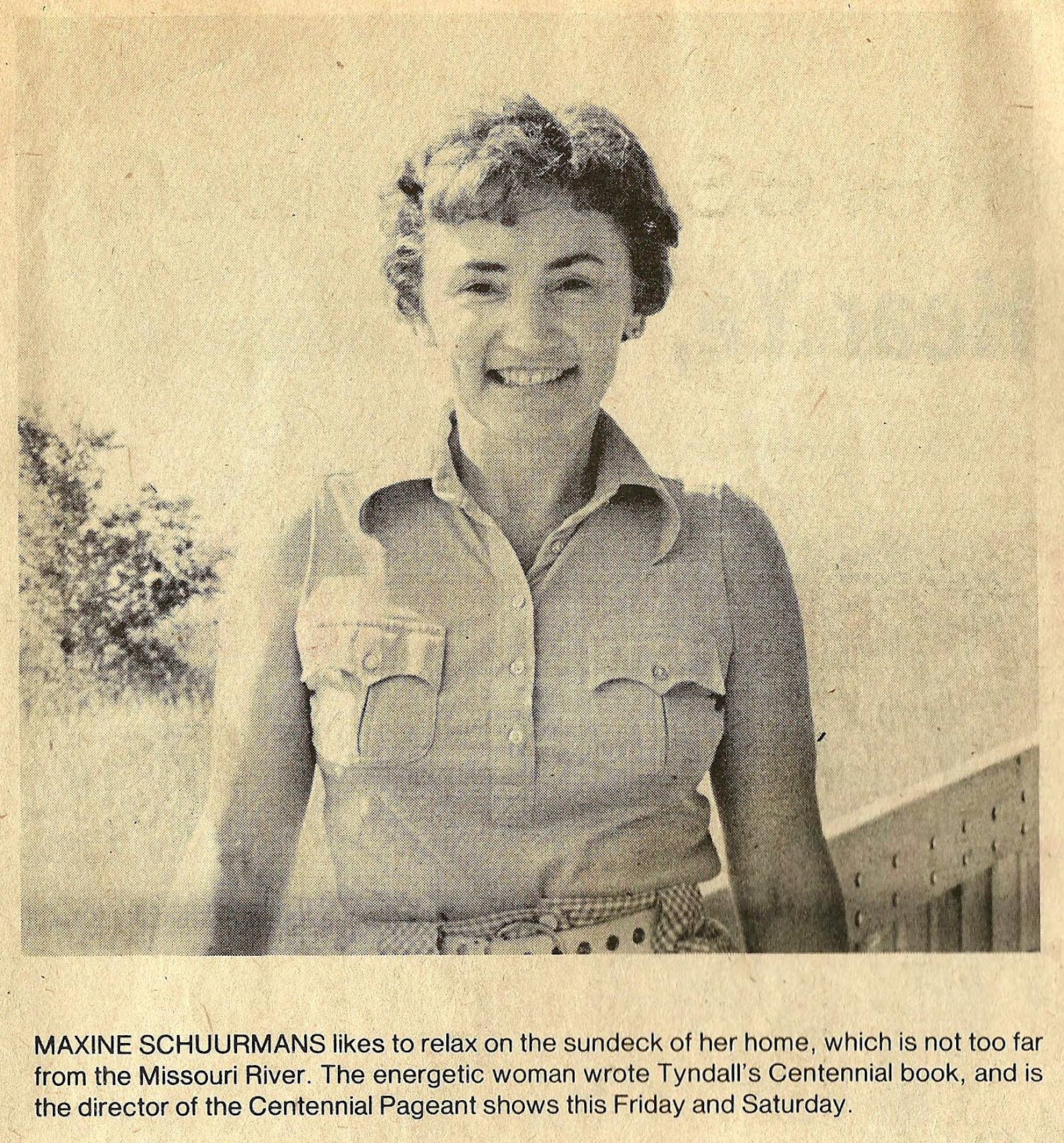
"I think my aim in writing this book was to prove that the same zest for life has always existed just as it does today," said Maxine Schuurmans in regard to her recently published Centennial book.
She gazes through the glass door of her riverside home and smiles suddenly. "See that over there?" She indicated a bluff to the northeast past the river. "That is what used to be old Bon Homme."
These and other facts are what Mrs. Schuurmans has been concerning herself with for the past year. In the summer of '78 she began researching the history of Tyndall in preparation for the town's 100th birthday.
"One thing led to another," she says. In the process of her research, she decided to write a book. Her centennial history is 148 page volume that was published at the end of June, and it illustrates various aspects of the town's social, economic, and civic growth.
The year long project has not been the only undertaking of Mrs. Schuurmans, though. In addition to writing the book, Mrs. Schuurmans other job is a full time one. She is the 8th grade English teacher at Tyndall High School, and is also the school librarian.
Ambition and activity have been integral to Maxine Schuurmans since her youth. A Tyndall High School graduate at 16, she attended college in South Dakota for two years.
"Then I decided I wanted to see what there was to see," Maxine reflected. She went to California to find work and stayed two years. At 20 she returned to the Midwest and married Virgil Schuurmans. The couple are the parents of six children who range in age from 18 to 30.
Eleven years ago when the youngest child, Tom, was seven, Maxine decided it was time to return to college. She finished at the University of South Dakota at Springfield, earning the degree that she now utilizes as the high school English teacher. Mrs. Schuurmans likes her job very much, stating that she has always enjoyed the junior high school age.
Her brown eyes twinkle as she smiles her easy smile. "You know, for being a lifelong resident of this area I sure didn't know much about it," she says. This she attributes to her country upbringing.
"I grew up on a farm about six miles directly east of Tyndall," said Maxine. "We just never got into town. It was kind of hard to fit in. There was a lot of difference then between kids from the country and the town."
In the process of her year-long research, Maxine has probably become one of the most informed people in Bon Homme County regarding the area history. This is enabling her to put together an hour and a half pageant depicting the town history.
Mrs. Schuurmans seems to take things as they come. Right now her prime worry seems to be when she will show the slides that are part of the show.
Somehow Maxine Schuurmans inspires confidence. "I'm not too worried. There's too much to do now for that."
Source: Tyndall Tribune & Register ~ July 5, 1979
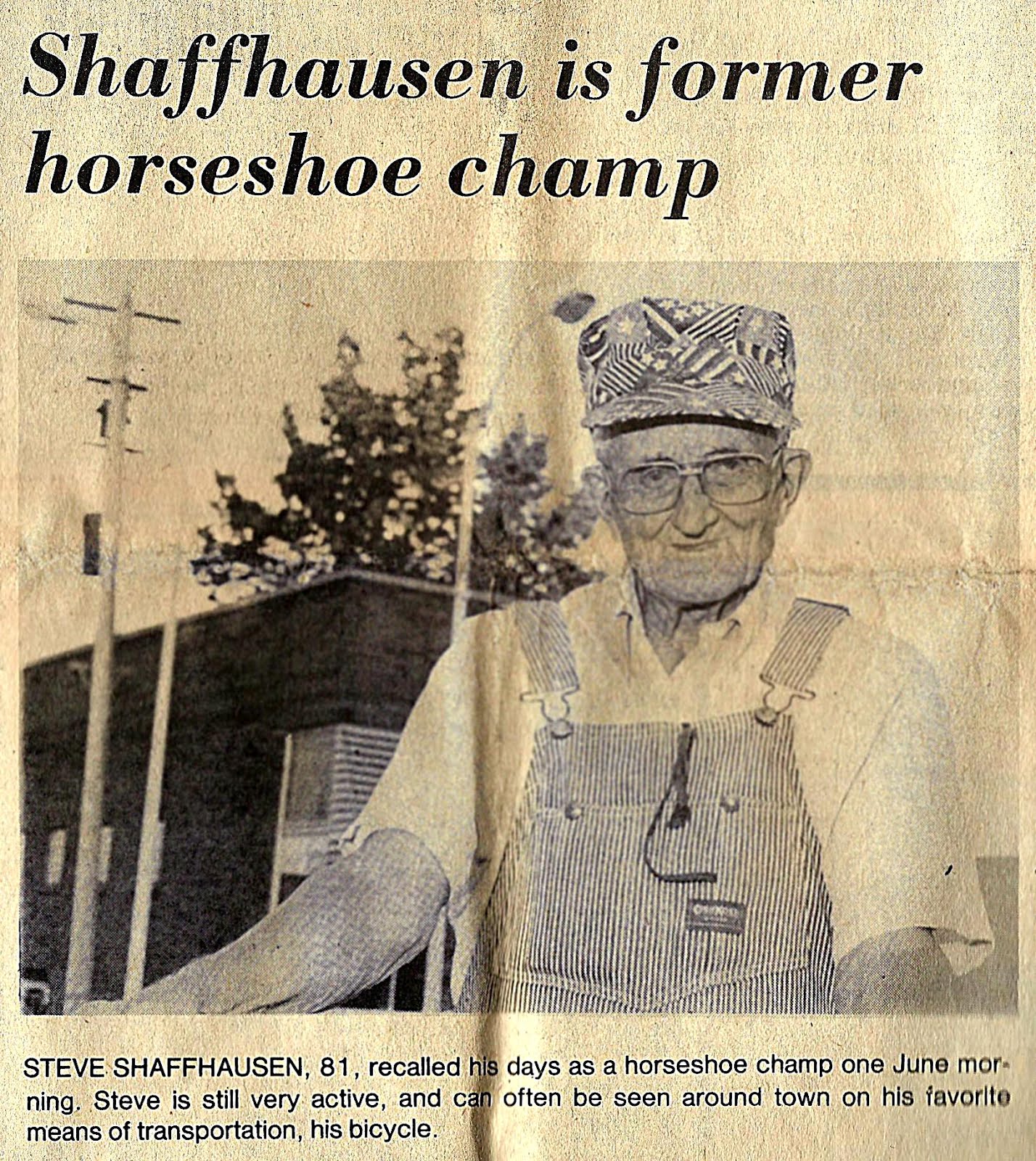
"I never loved a lady as much as I did my horseshoes," says Steve Shaffhausen. The 81 year old bachelor is a Tyndall native, and his main distinction is that he is a horseshoe champ.
"I was reading 'Minnesota Farmer' when I was about 27," Shaffhausen recalls. "They had an ad in there for horseshoes and I ordered some. I was crazy about those things. I practiced all the time, and then I went to contests in the Hills, in Yankton, Avon, and I even went to Great Falls, Montana. I was over fifty when I won the championship. My best record was 227 of 300 rings."
Shaffhausen says that he doesn't think that he could still do it, though. "My arm just isn't what it used to be. You know, kind of like the old gray mare! But when I was in the hospital several years ago, the doctor told me to get a bike and ride it to make my legs stronger. They are now, so I suppose that I could make my arms the same way if I'd practice.
Weather is not barrier for Steve's bicycle riding, and he rarely misses a day even on the coldest days of winter. He has always enjoyed the outdoors, being a hunter since his youth.
"I used to hunt everything. But I remember when I was a boy that you got paid a dime for every gopher that you killed. I once shot 43 gophers in a row without missing."
Shaffhausen and his eight brothers and sisters grew up on a farm about five miles southeast of Tyndall. He was the youngest child, born in 1898, and remembers in those days that they didn't get to town too often.
"We used to go to the dances though. My brother and I would go. They had a lot of dances at the Z.C.B.J. Hall. There used to be those special dances where the man got two partners. I'd always lose one because someone else would take her, and there I'd be, stuck with just one girl," he says morosely.
Shaffhausen tells of the dances in Tabor that he attended. "I remember the one that I went to when I didn't get home till five in the morning. I changed from good clothes right into my farm ones and went to do chores. About three in the afternoon I was out there in the field going like this ..." He nods his head for emphasis. "I went to bed really early that night," he laughs.
Another form of entertainment in the 1920s, Steve says, was the now defunct Cozy Theatre. "I never missed a Saturday night or a Sunday afternoon matinee. Me and this other guy would come to Tyndall and blanket the car so that it would start when we got out. I remember that old car. It was a '24 Model A, and it cost me $465 new."
Now Steve's form of recreation, he admits, is a little more sedentary. He watches television a lot, and he enjoys keeping up with current events. And for exercise, he rides his bicycle.
So if you see an overalled man riding a blue bike through Tyndall, it's just Steve Shaffhausen out on one of his many daily trips.
"I don't like to sit around," he asserts. "Keep moving. It keeps you young."
Source: Tyndall Tribune & Register ~ July 5, 1979
Source: Lodi (California) News-Sentinel ~ June 6, 1989
WAS ERECTED AT OLD BON HOMME VILLAGE IN SOUTH DAKOTA.
Interesting Letter Received by Deputy Superintendent of Public Instruction E. J. Taylor.
Deputy Superintendent of Public Instruction E. J. Taylor is in receipt of a letter from Col. R. S. Eyres of Fargo, one of the old timers in the Dakotas, who tells of the establishment of the first school house in Dakota Territory. The colonel also forwarded a copy of the Springfield (S. D.) Times, which contains an account of the dedication ceremonies, which were held near there this fall when a monument was unveiled marking the location of the building. The letter follows:
"Hon. E. J. Taylor,
"Bismarck. N. D.
"Friend E.J. -
'As per agreement made with you when at Bismarck recently. I am this day mailing to you under separate cover, a copy of the Springfield, S. D. which contains a write-up of a celebration held at old Bon Homme Village in the state of South Dakota, at which time a monument was unveiled, marking the spot where the first school house stood in the territory which now comprises the states of North Dakota, South Dakota, Wyoming, Montana, Nebraska and Idaho.
"As I informed you when at Bismarck. I had the pleasure of attending that reunion of old settlers, and would not have missed the treat for a great deal.
"'Old' Bon Homme Village is the oldest settlement of the territory I above described, and is to the state of South Dakota what Walhalla or Pembina are to North Dakota, and the old settlers of that state worship the very ground that the old village stood on. At one time it was a very prosperous and busy burg. However, today nothing of the old village remains except a postoffice and one old store.
"At the time the Chicago. Milwaukee and St. Paul railway built west through Iowa it was the intention to strike Bon Homme. However owing to the rough country tributary to the Missouri River at the point, the engineers changed their course and struck Yankton, the latter town was pulled over to that point. One old settler whom met while at Bon Homme informed me that the reason why the road did not touch Bon Homme was that the Indians chased the engineers away from their work of surveying into Bon Homme, claiming that they were sent there by the government to build the road for the purpose of getting the Indians to ride on the train and be killed, but as to the truth of this I will not vouch for, and am inclined to believe the other story, as there is every evidence that it would be a very costly undertaking to build into Bon Homme.
"It might be well for you to preserve the copy of the Times, as at some distant day the write-up will make very interesting reading.
"Yours very truly,
"R. S. EYRES."
Source: Bismarck (North Dakota) Daily Tribune ~ December 21, 1910
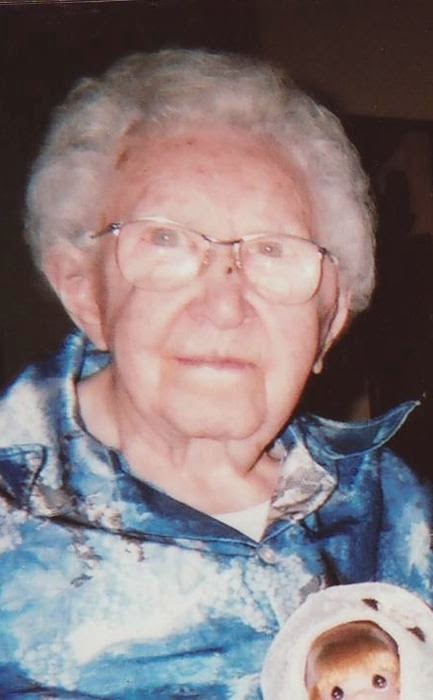
The amazing and loving Tillie Knodel will celebrate her 107th birthday on April 1, 2015 at Scotland Good Samaritan Home, Scotland, SD 57059. Help make her 107th birthday the best one ever! Send cards to Tillie Knodel at 130 Sixth St., Scotland, SD 57059.
Habit of a lifetime will be hard for Principal J. G. Wittmayer of Diamond Hill High to break.
So when school ends this June 2, two days after his 65th birthday, he even isn't going to try to break his habit of working.
Although he will be retired automatically from teaching in the public schools, he will look around and find himself another job after a vacation.
His blue eyes bright with self amusement, he comment "That will be the first time in my life I've been unemployed.He had a job before he was graduated from the University of Wisconsin and one before quitting every job he has held.
Thirty-nine years a teacher, 33 of the years have been in Fort Worth, the lst 18 as principal of Diamond Hill, he was in the commercial department in Paschal High. Born in Tyndall, S.D., May 31, 1885, Mr. Wittmayer worked his way south to Texas. He held teaching jobs in South Dakota, Nebraska, Kansas, Oklahoma and then Fort Worth.A year after he came here in 1917, he married an Oklahoma City girl.They now live at 3213 Lipscomb, have three children: John D. Wittmayer, Miss Genevieve Wittmayer and Mrs. Kathryne Hope Coleman.
A small man, five feet five inches and a little on the plump side.Mr. Wittmayer is quick mentally and physically.He sails in on any job he tackles, full steam ahead ... whether it is walking down a school hall or deciding a school policy.
He enjoys a quiet chuckle and has a quick smile.When the smile is of his face, Diamond Hill students know real trouble is in store.Then he tucks his chin down - looks very sternly through the upper parts of his glasses...and gets prompt results.
Comedy movies are his dish - "Why pay for seriousness and troubles shows when you get nothing else every day?" - but his taste in books runs to education, psychology and novels with an industrial or social background."I like a book that gives me a dose of the kind of people and their background."
Gardening is his principal recreation.Bulb flowers that stay put year after year are his favorites - iris, jonquils, daffodils, perennial phlox and pinks, tulips and such.He has never raised a vegetable garden.
Besides keeping the house in cut flowers, he has another chore - taking the clothes to the laundry."Don't tell that", he laughed, "of course I do it.I have the car all day.But it won't be true much longer because we are using the washing machine home now."
Source: Fort Worth (Texas) Press ~ February 9, 1950

U.S. Army Warrant Officer Kenneth Podzimek lost one of his men, but it wasn’t from enemy fire.
“It was an incident that we had at the unit, shortly after I became a warrant officer,” he told the Press & Dakotan. “The death was from a self-inflicted wound. It took everyone in the unit by surprise.”
Podzimek helped his South Dakota Army National Guard (SDANG) unit deal with the loss. The incident called upon him to use both his leadership and personal skills.
In another instance, he provided logistical planning and support for simultaneous June 2014 natural disasters in different parts of South Dakota.
And now, he is helping prepare his unit for an upcoming deployment to Kuwait.
The Avon soldier’s effective, diverse leadership skills have earned him national recognition. The U.S. Army announced Podzimek will receive the General Douglas MacArthur leadership award during a May 29 ceremony at the Pentagon in Arlington, Virginia. Gen. Raymond Odierno, the U.S. Army Chief of Staff, is scheduled to present the awards.
Podzimek serves as a construction engineer technician in the 155th Engineer Company in Wagner. He has served his entire 14-year National Guard career with the Wagner unit, and he becomes the first SDANG warrant officer to receive the award, according to a news release.
The U.S. Army honors one warrant officer and six officers annually with the MacArthur Award. They come from the active Army, National Guard and Army Reserve.
The honorees demonstrate the ideals for which MacArthur stood — duty, honor and country. Each soldier receives an engraved 15-pound bronze bust of MacArthur mounted on a walnut pedestal.
As of last year, only 677 recipients had received the MacArthur award in its 27-year history out of thousands and thousands of officers, warrant officers, lieutenants and captains.
To be chosen among so many great warrant officers and to receive this award is a humbling experience, Podzimek said.
“When I found out that one warrant officer in the entire National Guard would be selected, I figured my chance of winning this award were slim to none,” he said. “When I read the list of award winners and saw my name ... I had to read it about three to four more times. I couldn’t believe it.”
One example of Podzimek’s effective leadership style was demonstrated when the 155th suffered the loss of a soldier, said Lt. Col. David Dailey, 153rd Engineer Battalion commander who recommended Podzimek for the MacArthur Award.
“He led from the front, took the time to talk to his soldiers individually and mentored them through a very difficult time,” Dailey said in a statement. “He has been an instrumental leader, using his abilities to mentor his subordinates to become a cohesive and resilient platoon.”
Podzimek said his focus remained on his men and their ongoing needs in the midst of losing a fellow soldier. He looked at the soldiers as individuals, not strictly as a unit. “I just let them know that they had somebody to talk to, if and when the time was there and they were ready,” he said.” It’s different for each person, and different people handle it differently. I may handle it differently than the next 100 people — good, bad or other.”
Another unexpected situation — actually, two situations — challenged Podzimek’s ability to lead in the face of an emergency. In June 2014, South Dakota was hit at the same time with two natural disasters — a tornado which destroyed a large portion of Wessington Springs and flooding that devastated parts of the southeast corner of the state and impacted neighboring areas such as Yankton.
Podzimek’s technical knowledge shone when he managed more than four construction projects and his team responded to the flood operations and the tornado clean-up, Dailey said. “He always makes an extraordinary effort to ensure his company is able to accomplish any mission,” Dailey said. “His dedication and integrity to the mission first, epitomizes the ideals for which this (MacArthur) award stands for.”
Podzimek provided a much more modest account of his role in the two disaster operations. He emphasized he was completing an annual training (AT) project in Yankton at the time and didn’t actually travel to Wessington Springs. He said he provided more of a back-up role in the two disaster responses.
“Last year, our annual training was done in Yankton at the Easton (archery) complex,” he said. “We were constructing comfort stations between two Olympic ranges. The AT was on the downhill slope, and I was able to move our feet faster and help with different things (on the tornado and flooding responses).”
Podzimek characterized his disaster role more as communicating the tornado and flooding situations as they unfolded and coordinating the logistical needs for both disasters. Those needs could range from personnel to vehicles to equipment.
“I consider myself a very small part of it, personally,” he said. “There was a lot of large movement, and we just made sure there weren’t any hiccups.”
Podzimek credits his leadership style as a direct reflection of his former SDANG leaders.
“I’ve had the luxury of having good leaders throughout my military career,” he said. “They’ve taught me to do more than the work of a commander, to get your hands dirty and do some manual labor right alongside your soldiers.”
Podzimek admitted he didn’t even know he had been nominated from the MacArthur leadership award.
Coincidentally, he received his award notification while attending a military school in Arkansas preparing for the 155th Engineer Company’s upcoming deployment to Kuwait.
“We’ll be going to Texas in August. Then, after a couple of months of training, we’re going to Kuwait. When we leave, it will be a nine-month stay, but that could change,” he said. “For the most part, I would say we’re a unit that’s qualified for vertical construction — concrete work, wiring up buildings and doing some plumbing, carpentry and masonry.”
The Arkansas military school focused on the logistics of moving to an assigned theater, Podzimek said.
“We learned how property will be moved from Wagner and Rapid City down to Texas,” he said. “We studied logistically how to move all the vehicles, equipment and general things. We learned, by the book, how to transport things by ship or planes.”
Podzimek isn’t a stranger to Middle East missions. The Wagner unit deployed to Iraq in 2004 as part of the 153rd Engineer Battalion.
“I think that mission provided valuable experience,” he said. “We know how to plan, what to expect leading up to leaving the country and what needs to be completed. We have become proficient with our tasks, the different things before we leave the United States. We know a lot of what to expect.”
An August send-off is planned in Wagner for the upcoming mission, Podzimek said.
But first, he will travel to Washington for a May 29 ceremony honoring the MacArthur Leadership Award recipients. “We’ll do a rehearsal in the military dress uniform. Then, we’ll have the actual awards ceremony around noon with four-star Gen. Raymond Odierno,” he said.
Outside of his National Guard commitment, Podzimek balances duties as a full-time electrician for the U.S. Army Corps of Engineers and as an owner of a part-time cooling and heating business.
“He maintains a full schedule with his civilian and military obligations but always finds time to remain active in his community and spend time with his family,” Dailey said.
Podzimek volunteers his time and resources to his local fire department and VFW Post 7319. He is currently providing assistance for projects with the Wagner VFW post and the Dante fire department.
“His willingness to give back to his community through volunteering his time to local organizations directly reflects his values,” Dailey said.
Podzimek quickly credits the support of his family. He and his wife, Whitney, have three young children: Parker, 5; Palmer, 3; and Bode, who was born Feb. 11.
“I give a big thanks to them,” the soldier said. “I wouldn’t be able to do a lot of this if it wasn’t for my family. They’re a big part of this.”
Source: Yankton (South Dakota) Press & Dakotan ~ April 6, 2015

Things are popping on the Namminga farm west of Springfield. Ernie Namminga, farmer and director for Bon Homme Electric, started growing organic popcorn in 2010. Of the 600 acres he farms, 39 acres produce organic popcorn. Those acres see no pesticides or herbicides in the farming process.
Namminga states that to be USDA certified the ground had to be commercial fertilizer free for at least three years. Prior to 2007, the ground was grassland so it passed the USDA qualifications. That was just one of the requirements for certification. He has to pass an annual inspection and fill many pages of paperwork every year to be certified by OneCert.
The untreated seeds for planting must also be approved and certified. The seed cannot be genetically modified organism (GMO). This refers to plants and animals with an altered genetic make-up by a non-natural means in order to incorporate genes from another organism.
Namminga has several options to purchase the seeds: Blue River Seed, Albert Lee Seed House and Schlessman Seed.
Planting season starts around mid-May, depending on the weather. Five days after planting the popcorn, the field is harrowed.
"Weeds are a big problem when raising organic food," Namminga said.
During the season, he uses a rotary hoe on the crop a couple of times and cultivates it twice.
At the present time, Namminga farms 80 percent organic on his land. (He said his goal is to go to 100 percent organic.)
Besides popcorn he also raises organic soybeans, field corn and alfalfa.
Extra work is required to raise organic foods.
"People don’t realize that all wagons must be cleaned before being used for the organic crop," said Xinna, Ernie’s wife.
In the fall, 95 days after planting, the crop is harvested at 16 percent moisture.
K & W Popcorn out of Trenton Missouri, picks up the seeds, and cleans and processes the popcorn. At the manufacturer, an electric eye examines each kernel of corn. Any popcorn seed with a crack in it is rejected. After the corn is processed, it is packaged in 2 pounds and 50 pound bags.
In an average year, 3,300 to 3,400 pounds of popcorn is harvested per acre. Namminga noted that 2014 was his best year at 3,750 pounds per acre.
After the popcorn is delivered back to the Namminga farm, labels are put on the product by the family.
"The grandchildren help do this," Namminga said.
He noted that Bernie Hunhoff of Yankton helped design the label. Hunhoff has also helped in the promotion of the popcorn. A recipe is on the back of the package.
"The recipe makes really good Caramel Corn," Xinna said.
In Yankton, you can find the organic popcorn at HyVee. In Wagner, the movie theater sells the organic popcorn to their movie-goers, the school purchases the product and the Commercial Bank. In Avon, the organic popcorn can be purchased at Ron’s Market.
Source: Yankton (South Dakota) Press & Dakotan ~ April 4, 2015

Sister Marie E. (Meg) Gemar, a member of the Sisters of St. Francis of Dubuque, IA will celebrate her Golden Jubilee Saturday, June 20 at Mount St. Francis Center in Dubuque, IA.
Sister Meg is the daughter of the late Elmer and Doris Gemar of Tyndall. She graduated from high school in Springfield and was a member of St. Leo's Parish, Tyndall. She entered Mount St. Francis September 3, 1964. Sister made her first vows August 11, 1967 and final vows April 28, 1973.
Sister Meg received a bachelor's degree in biology from Briar Cliff University, Sioux City, IA; a master's degree in physiology from St. Mary's, Winona, MN; and a master's degree in earth literacy from St. Mary-of-the-Woods, IN.
She taught high school biology and science courses, coached volleyball and golf for 44 years in Waterloo, IA and served as a community minister to the retired sisters at Mount St. Francis. She is currently giving presentations on environmental issues and nature and leading retreats on the "The Sacredness of the Universe."
Source: Tyndall Tribune & Register ~ June 10, 2015
In the matter of the petition of Torrence Brothers for an elevator site at Tabor.
On April 7th, 1904, the following complaint was filed with the Board of Railroad Commissioners by Torrence Bros of Tabor, South Dakota.
Torrence Bros., Complainants, Against The Chicago, Milwaukee, & St Paul Ry. Co., Defendant.
To the Board of Railroad Commissioners of the State of South Dakota:
You are hereby notified:
1. That the above named railroad company is operating a line of railroad in this state.
2. That the firm of Torrence Bros., whose residence and post-office address is Tabor, Bon Homme County, South Dakota, desire the privilege of constructing a grain elevator, to be constructed of wood In such a manner as to meet the requirements of a standard elevator, and to have a capacity of from 10,000 to 15,000 bushels, upon the warehouse lots of the Chicago, Milwaukee, & St. Paul Railroad Company at the station of Tabor, Bon Homme Co., State of South Dakota, the said station being one their regular stations on this line of said Chicago, Milwaukee, & St. Paul Railroad, and the said Chicago, Milwaukee, & St. Paul Railroad owns and has vacant for warehouse purposes warehouse lots at said station.
3. That your complainant did on or about the 10th day of January, A.D. 1904, request of the said Chicago, Milwaukee, & St. Paul Railway Company the privilege of constructing such grain elevator upon a warehouse lot of said railroad company at said station of Tabor, but that the said railroad company refused and still refuses such request.
4. That the construction of such grain elevator is necessary and the public welfare will be materially advanced thereby.
Wherefore your petitioners pray that you appoint a time for investigating this complaint, as by law provided, and that after investigation and consideration of all the circumstances surrounding the case you make an order fixing the location of such elevator upon a warehouse lot of said railroad company at said station, all as provided by law.
(Signed) Torrence Bros., Complainants.
The foregoing complaint was accompanied by a petition purporting to be signed by eighteen citizens, property holders and business men of the town of Tabor, wuich was to the following effect:
Tabor, South Dakota, April 2, 1904.
To the Hon. Board of Railroad Commissioners, of the State of South Dakota:
Sirs: We, the undersigned, citizens, property holders, and business men, residing within the said town of Tabor, Bon Homme County, South Dakota, do hereby petition your honorable Board to grant the petition of Torrence Brothers, of Tabor, South Dakota, for a site upon which to build a grain elevator on the warehouse lots ot the Chicago, Milwaukee, & St. Paul Railroad Company in the town of Tabor, Bon Homme County, South Dakota, at some convenient place on said warehouse lots within said town.
We respectfully represent that the total number of elevators, within said town of Tabor, Bon Homme County, South Dakota, is not as large as in adjoining towns in proportion to the number of bushels of grain marketed. And we further represent that there are at present only two elevators in said town of Tabor, and that the same are owned by "line" companies, and that said companies, having a monopoly of the market, and also owning elevators in adjoining towns, have kept and are persistently keeping the price of wheat unreasonalby low in said town of Tabor, thus forcing the farmers to haul tneir grain to other towns to the detriment of said town of Tabor.
We further represent that said Torrence Brothers are grain buyers of experience, and are in every way competent to operate an elevator.
All of which is respectfully submitted.
Copies of the foregoing complaint and petition were forwarded to the C.M. & St. P. Railway Company with the request that they give the matter their early attention, and advise the Commission of their conclusion. No reply having been received from the Railway Company, the Secretary again wrote the railway company in regard to tile case, stating that from the information at hand the Commission were of the opinion that the natter was worthy of investigation by the Board and that unless a satisfactory adjustment was soon made it would be necessary to call a hearing at Tabor in the near future. Under date of May 28th, General Manager Williams replied as follows:
"Replying to your favor with reference to the application of Torrence Brothers for an elevator location at Tabor, S.D., I beg to explain that investigation shows that there are at present two good elevators and a flouring mill located at that point. The elevators are owned, one by McCaull-Webster Elevator Co., which might perhaps be termed a line elevator, as they have elevators at a number of other points on our line, and one by M. King, who I believe is a resident of Yankton or in the vicinity.
The total shipments of grain of all kinds from that station have been as follows:
1901 .......... 102 cars
1902 .......... 114 cars
1903 .......... 105 cars
I understand that prices have always been well kept up at that place and that all of the grain tributary to that point has been marketed there. When the McCaull-Webster Elevator Co. made application some time ago for a location at that point, we told them that we did not think there was business for another house there and they bought out one of the elevators because, I think, they agreed with us that with a third one there none of them could make a living, and I believe you will agree with me that these figures indicate that the public welfare will not be materially advanced by the construction of another house at that point."
It appearing to the Board that the case could not be amicably adjusted by correspondence it was ordered, at a meeting of the Board held on the 31st day of May, that a meeting be held at the said station of Tabor on the 28th day of June, 1904, commencing at the hour of ten o'clock in the forenoon of tnat day for the purpose of investigating the said petition and complaint and the refusal of the said railway company to permit Torrence Bros. to construct a grain elevator upon its warehouse lots at said station, and for the purpose of considering all circumstances surrounding the case in order to determine whether the public welfare would be advanced by the construction of such grain elevator at the said station. Notice of said hearing was duly served upon all the parties in interest. After the service of said notice and before the date set for the hearing the following telegram was received from General Manager Williams:
"With reference to proposed hearing at Tabor: on further investigation we have decided that there are no objections to giving Torrence Bros. a location at that point and if they will take the matter up with Superintendent Beardsley details can be carried out at once."
The complainants were advised of the conclusion of the Railway Company to grant their petition, and there appearing to be no necessity for a hearing, the case was closed.
Source: Fifteenth Annual Report of the Board of Railroad Commissioners of the State of South Dakota ~ 1904
How a Representative Granger Thrives on Cattle, Hogs, and Corn
Last Saturday, Oct. 25th, your correspondent visited Jas. K. Cooley, one of Bon Homme county's most enterprising stock growers. Mr. Cooley lives about five miles west of north of Bon Homme village. After we had enjoyed the hospitalities of his home in the line of a good dinner, we went out to view his stock and farm. First we were shown his corral for his fatting cattle. In this enclosure he feeds eighty head, all steers. Some of these are of colossal proportions of the Texas breed. By the time these four oar loads of steers are ready for the market Mr. Cooley remarked he purposed to realized an average weight of fourteen hundred pounds to the steer and we doubt not it will exceed those figures rather than fall below. One hundred and twelve thousand pounds of beef for one farmer is no trifle.
Turning to the lower part of the corral I noticed what in our distant approach appeared like a sail boat. "What have you here?" your correspondent asked. "Oh, that is my invention put in position on trial two days ago to bear the burden of supplying water for this herd which you must know is not a small affair. The cost was less than five dollars, all told labor added, and you see this capacious tank has been filled and running over, the result of one night's work. The sails so adjusted as to utilize the wind from whatever quarter it blows the wind-mill did its work all the same backward or forward."
I said to Mr. C.: You owe it to your poor neighbor who could not in any way scrape together money sufficient to buy one of the prairie adornments costing $100 less or more, to tell them of your wonderful cheap invention which answers all the purpose of the great wind-mill. What difference will it make so long as the cheap institution does its work all the same?
From the corral, we next went north a full quarter to see his swine herd. Three barbed wires low down kept these "porkers" in their place. On one side, the pen opens on a fine lake, plenty in water from four to six feet deep in the middle part; no windmill required to raise the water here, the hogs have plenty as they attest. To supply this herd of 115 head and the steers in the corral, Mr. Cooley has raised a crop of corn of 325 acres of good sound grain, filled out plump and complete to the end of the cob. These 115 head will average from 350 to 400 pounds each, by the January market.
Then the stock hogs and the young cattle range in stalks and timothy fields and eat blue grass which is successfully grown on this ranch. I was shown an ear of corn which this model stock raiser brought from his native state lately dear, old Maryland, which counted eighteen rows and sixty-seven plump grains to the row. I suppose he looks on these ears as models which he hopes to scribe up to coming years.
Now put sixteen years in the past out of history, and the wild green and lake beds possessed the Cooley farm.
Source: Press and Daily Dakotaian ~ October 29, 1884
A warrant was sworn out before Justice Bart Cole at Bon Homme last week by Josephine Cuka charging one Henry Snyder with the crimes of seduction and abortion. Before the warrant could be served on him Snyder had skipped for Iowa, and at last accounts had not been heard from.
Source: Press & Daily Dakotaian (Yankton, SD) ~ April 13, 1882
Last Wednesday, while a couple of Hollanders were attempting to cross the main branch of Choteau creek near John Rouse's farm, they met with a sad misfortune. One of the men was standing on the seat holding a five year old boy on a feather bed, and in crossing the creek he accidentally slipped off into the water an dwas drowned. He was found dead a short distance below.
Source: Press & Daily Dakotaian (Yankton, SD) ~ April 5, 1884
W. J. Wilcox, editor of the Tyndall Tribune, accompanied by his wife, drove down from Tyndall to Yankton Saturday afternoon in three hours and twenty minutes. The ride was a very pleasant one because the road lay through one of the gardens of southern Dakota.
Source: Press & Daily Dakotaian (Yankton, SD) ~ April 25, 1885
Joseph Jilek, a Bohemian farmer of Charles Mix county, left his home Sunday morning with six sacks of flax for the Tyndall market. In the afternoon of that day he got lost, he unhitched his team, tied them to the wagon, gave them their feed and set off to look for the road. He wandered around Sunday night, and all day Monday, losing the place where the team was tied, but on Tuesday morning about 9 o'clock he found it. He hitched the horses to a wagon, went about one mile an dlost the road again. Then he wandered around not knowing where he wsa until Thursday morning. He was confident that it was useless to take the wagon farther, and his fingers were so badly frozen that he was unable to unhitch. He used his teeth to loosen the horses from the agon, rode on one and led the other until near Martin Roose' place ten miles west of Tyndall, where he was taken in and found to be badly frozen. His feet were swollen so that Mr. Roose was forced to cut his boots off, and his hands were frozen stiff. Mr. Roose gave the man somehting to eat, th efirst morsel he had taken into his stomach for five days and then brought him to town, leaving him under Frank Houska's care. Dr. Moore was summoned and administered all the relief possible to the unfortunate man. It is feared that his feet and hands will have to be amputated. He is a single man thirty-five years of age.
Source: Press & Daily Dakotaian (Yankton, SD) ~ February 26, 1885
Tyndall Tribune: A serious accident occurred last Wednesday at the new elevator in this place. Duane Ford and Gus Smith were shingling on the roof when their foot brace gave way, precipitating them to the ground, a distance of about thirty-five feet. Mr. Smith had his left arm broken at the wrist, the bone protruding through the skin, and was badly bruised on the head. Mr. Ford was very much shaken up and bruised but fortunately no bones were broken. Drs. Carlin, of Tyndall, and Dye of Missouri, set the arm of Mr. Smith and attended to their injuries. Both men are now able to be out and are fast recovering from their injuries. It is a miracle that they were not dashed to pieces as they struck in the center of the railroad track.
Source: Press & Daily Dakotaian (Yankton, SD) ~ July 10, 1883
South Dakota Town Has Narrow Escape from Destruction
Tyndall, SD, April 27 – During a terrific gale last night the postoffice building and store of William Metzgar were burned to the ground and the whole town was threatened, but the fire was stopped at the two-story stone sore of Joseph Kiehlbauch. The losers are: A. A. Dye, Madison, Wis., owner of the post office building, William Metzgar, postmaster; C. H. Stilwell and Joseph Kiehlbauch.
Source: Evening Times – Republican (Marshalltown, Iowa) ~ April 27, 1901
General Merchandise Store and Other Properties at Total Loss
Tyndall, SD – Jan. 27 – Fire at 4 yesterday morning destroyed Schwerdtmann & Co.’s general merchandise store, which is a total loss, with insurance of $8,500. F. A. Dite’s tailor establishment is also a total loss, and Blazk’s saloon was gutted. Bellew & Wilcox’s art studio also burned. The origin of the fire is unknown.
Source: Evening Times – Republican (Marshalltown, Iowa) ~ January 27, 1904
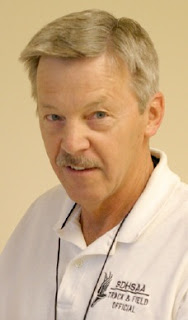
It was spitting cold rain, then sleet outside Dr. Bernie Schuurmans' dental office in Madison Friday (today), the day before the Danny Barker Relays was to be held at Trojan Field.
Even though Schuurmans was told the Barker Relays had been postponed, it didn't deter him from checking his starter's gun.
He's been the official starter at the Madison track meet for the past eight years, after being a volunteer for 22 years. "Danny Barker, Jim Cordts and Jerome Garry all encouraged me to become a track-and-field official," said Schuurmans.
"Early in 2000, I took the test and became a licensed official."
Schuurmans is being honored as this year's Honorary Referee for his tireless efforts relating to the Barker Relays.
"I feel honored to receive the Barker Relays referee award," he said. "Track has been my favorite sport, and I've enjoyed working Madison track meets the past 30 years."
The 1997 Barker Relays was the only year that Schuurmans missed, and that was to attend daughter Amy's graduation from the University of Nebraska-Lincoln. Amy and her husband Jeff Hellbusch live in Tucson, Ariz., where she is a radiologist. They have three children, Dylan, Ethan and Sydney.
Schuurmans' son Jesse works as a web designer in Bismarck, N.D. His daughter Olyvia lives in Madison and attends Madison Elementary School.
Their two other sons, Tyler and Tanner, both live in Lincoln, Neb. Tyler is a dental student at the University of Nebraska, where Tanner is a freshman. Tyler is married to the former Alison Friedow of Madison.
Beth, the Schuurmans' other daughter, lives in Louisville, Ky., where she is a social worker.
Track roots go back to Tyndall. Both Schuurmans and his wife Terri attended Tyndall High School and were part of Tyndall's track team.
Bernie, who graduated in 1968, competed on Tyndall's Class B championship teams of 1966 and 1967 and the runner-up team of 1968.
He closed out that senior '68 season winning the low hurdles state title. He also participated in football and basketball.
Terri, who graduated in 1969, was a member of the '69 State B girls championship squad -- the first ever for Tyndall. Schuurmans attended the University of South Dakota, participating in freshman basketball and track for two years, competing as a hurdler. He graduated with a bachelor's degree from USD in 1972.
After attending the University of Nebraska Dental School, Schuurmans received his DDS in 1976.
Prior to coming to Madison in 1978, Schuurmans served in the Army Dental Corps at the U.S. Military Academy in West Point, N.Y., for two years. Schuurmans has served Madison community well.
Schuurmans is quick to point out that all of his and Terri's children have been involved in Madison sports, especially track.
"Terri and I insisted that our five children all give track a try," he said. "They all earned varsity letters in track under head coaches Frank Guenther and Jerome Garry. Tyler and Tanner enjoyed being on state championship teams, respectively, in 2000 and 2007."
Schuurmans initiated the St. Thomas Knights of Columbus Track Meet, coached many youth softball and baseball teams and was a one-time operator of the Madison Mini Golf Course. Schuurmans has been involved both as a participant and a member of the S.D. Senior Games board of directors. He is currently the organization's vice president.
In other community activities, Schuurmans was a two-term member of the Madison School Board and a past Cub Scoutmaster.
"Being associated with the Senior Games, I plan on being active with track and field 'til I'm 80 or 90," said Schuurmans.
Source: Daily Leader (Madison, South Dakota) ~ April 25, 2008
Want to live to be 100? "Then don't smoke or drink!"
That's the advice from Gladys Runestad. And she should know. She celebrated her 100th birthday during an open house on Sunday afternoon at Heritage Senior Living.
Want to live to be 100? "Then don't smoke or drink!"
That's the advice from Gladys Runestad. And she should know. She celebrated her 100th birthday during an open house on Sunday afternoon at Heritage Senior Living.
There is one more bit of advice: "Eat chocolate whenever you get the chance." It's Runestad's favorite.
Runestad was born on Dec. 11, 1911, one of five children -- three girls and two boys. As a young girl she enjoyed reading, a passion which eventually led her to become a school teacher. Graduating in 1930 from Tyndall High School, she spent a year working as a stenographer but then decided to enroll in Southern State Normal School in Springfield.
After only a year in college, she was asked if she might want to become a teacher. At that time, you could get a teaching certificate after one year.
Runestad's first teaching job was in a country school in Bon Homme County. She had 26 students ranging from first grade through 12th grade. Her pay was $50 a month.
Runestad spent two years in the Bon Homme school before taking a position in a school at Highmore. It was there she met her future husband, Herron. He was the son of the lady who had hired her for the teaching position in Highmore.
The two young people hit it off from the start and when she returned to Tyndall for another teaching position, Herron soon followed, working for a farmer during the summer.
The couple was soon married and moved to a farm north of Howard, where her husband had found work picking corn by hand for an uncle. It was the Dirty '30s, work was hard to find and times difficult for many in the area. Eventually Herron started farming himself.
The couple had a daughter, Sharon (Abraham), and after she was in first grade, Runestad was urged to return to teaching. Teachers were hard to find at the time and she agreed to fill in for the last month of the school year.
She continued teaching. Her last teaching position was teaching seventh- and eighth-grade social studies in Howard. She retired in 1974. The couple moved to Madison in 1979.
She enjoyed bowling, playing cards and belonged to both the Ladies Aid at church and a retired teachers group. She was known for embroidering on dish towels.
Today her passion is watching game shows on television. She is also active in a Ladies Aid organization at the living center.
Attending the birthday celebration on Sunday were her daughter Sharon and a host of grandchildren, great-grandchildren and even great-great-grandchildren.
Pressured to give her recipee for a long life, Runestad just smiled and said, "Stay away from the cigarettes and booze -- and spinach." Spinach?
"Yes, I don't like spinach very much," she laughed. But chocolate...that's another matter.
Source: Daily Leader (Madison, South Dakota) ~ December 12, 2011
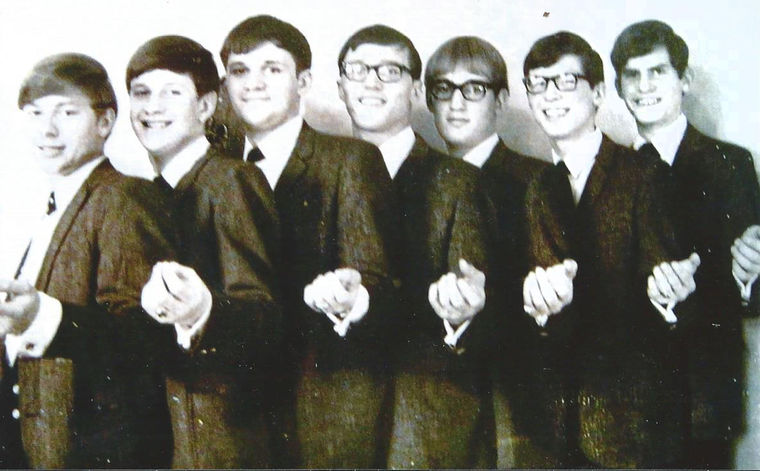
The Tensions in a promotional picture
L-R: Dan Kubel, Bob Bainbridge, Denny Gale, Don Hajek, Fred Sayler, Doug Hajek, & Denny Cokeley
Everybody and their brother, it seemed, were pounding on drums, making music in the garage, back in the 1960s.
But a group of Tyndall boys, including two brothers, actually moved from the garage, toured the area and made a name for themselves.
They had the beat — you dig?
They called themselves “The Tensions,” maybe because when they played, there was a certain tension in the air, the vibes of good groovin’ music. Don Hajek, his brother Doug and several others made up the core of the band: Larry Meyer, Denny Cokeley, Dan Kubel, Fred Sayler and Bob Bainbridge. Considered a Tyndall-based band, three of the members were from other towns: Sayler from Menno, Gale from Wagner, and Bainbridge from Scotland.
Members of the group gathered again recently as the Tensions received induction into the S.D. Rock & Roll Hall of Fame April 16 in Sioux Falls.
Don Hajek, now living in Sioux Falls, said the group started out as high school freshmen, calling themselves first The Excaliburs, then the Knights of the Round Table, and eventually, The Tensions. They played at first mostly at Groveland Park, a nearby dance pavilion that packed the crowds in every weekend there was a dance. Groveland also was recognized a couple of years ago with membership in the S.D. Rock & Roll Hall of Fame.
Being so close to Groveland also may have influenced Don and the others to form a band.
“We hung out at Groveland,” said Don, adding, “and everyone wanted to be in a band — I had a cousin and he was a drummer that got to play with a lot of good bands on tour, so they thought I would be a drummer, but that didn’t last long.” He centered in on the guitar. Many times the boys had cleaned up the park to be able to get in free—and now they were the music there.
Eventually the group was touring the local area: Rest Haven outside of Lake Andes, Milltown northeast of Parkston, and beyond to Vivian, Rapid City, Gregory, Winner, and south into Nebraska.
“We would maybe travel 100 miles to play, and get $150 for the night,” recalled Don. That wasn’t much for a group of six or seven guys, even back then.
”We played rock ‘n roll, rhythm ‘n blues, and played a lot of Temptations,” said Don, adding, “anything with horns.”
A proud memory of Don’s is the year the band won top honor among 14 bands competing in the Battle of the Bands in downtown Sioux Falls — performing on a flatbed parked in front of J.C. Penney.
Another good memory: the band playing for a Gov. Nils Boe dedication. They also played for many high school proms.
“Wherever we could get work, we would play,” said Don, “and make a few bucks.”
Every town back then seemed to have a band, and there was a certain amount of rivalry between the Tensions and Tripp’s Postmen, also honored last weekend. Now, members share their memories. The old dance halls have been torn down, lost to weather and age.
Individuals from the bands who still love to play find themselves entertaining at nursing homes. Other band members may have died or moved far away.
But the S.D. Rock & Roll Hall of Fame gives the opportunity to reminisce and save the memories.
Source: Elizabeth “Sam” Grosz for the Yankton Daily Press & Dakotan ~ April 20, 2016
The Czech Heritage Preservation Society of Tabor honored five local pioneers at a public performance. Portrayers of Ferdinand Cach, Johanna Kocer, Matt Petrik, Joseph Vyborny, and Joseph Zitka each presented a short program about their lives at two performances May 15, 2016 in the Mini Czech Pioneer Village located in Vancura Memorial Park on Tabor's main street. The portrayers gave a presentation for the Tabor Elementary School students May 16.
The final heritage presentation will be given Thursday, June 16 at 5 p.m. as a Czech Days kick-off performance. This presentation will be given as a first come basis for seating purposes in the park buildings.
Ferdinand Cach was born January 14, 1850 in Hlinska, Chudrin County, Bohemia and died November 28, 1936 in Scotland, South Dakota and is buried in the St. George Catholic Cemetery. His story was compiled by Gary and Evie Kronaizl, and his character was re-enacted by Randy Hall and Gary Kronaizl.
Cach, a carpenter by trade, constructed many buildings in the area including the St. John the Baptist Church originally constructed on the Nedved Cemetery land, purchased by Albert Mudloff, Sr. and moved to his farm to be used as a granary and survived a tornado and then purchased by the Czech Heritage Preservation Society and moved to the Vancura Memorial Park. He constructed the roof on the original chalk rock St. Wenceslaus Catholic Church in Tabor and also the roof on the original chalk rock St. George Catholic Church in Scotland. He was contractor for the Hutchinson County Courthouse located in Olivet, which is still in use today, just to name a few of his project.
Matt Petrik was born July 6, 1838 in Brezi, Pisek District, Bohemia. He died October 25, 1927 in Wagner, South Dakota and is buried in the St. Wenceslaus Catholic Cemetery in Tabor, South Dakota. His story was compiled by Alice Petrik and reenacted by Lumir Ruman.
Petrik was a mason by trade. This is the story of the life of Matt Petrik, coming to America in 1867 with his wife Marie, son Frank, and his elderly parents, Frantisek and Katherine Petrik. The Petriks settled north of Tabor and lived in covered wagons before building their home.
Matt died at the home of his daughter, Mrs. Joseph Soukup. He had a family of 11 children. Mr. Petrik arranged and wrote the Bohemian music for the 1890 band. The music is still played today at Czech Days in Tabor by the "Tabor 1890 Band." Many of the Petrik relatives have played this music in the band over the years. Matt Petrik played the clarinet and violin in his band.
Johanna Kocer was born May 16, 1848 in Kvitkovice, Budejovice Region, Bohemia and died February 27, 1932 in Tabor, South Dakota and is buried in the St. Wenceslaus Catholic Cemetery. her story was compiled by Kristi Kocer and reenacted by Kristi Kocer who is a great grandniece.
Johanna Kocer was a pioneer woman, who journeyed with her family from Bohemia to Dakota Territory in 1869 leaving all that was familiar to her behind. Their journey was one of innovation, hardship, and hope. Like so many other Czech immigrants, she dreamed of a land of freedom and opportunity. Under the Homestead Act of 1862, Johanna staked claim to and homesteaded land which would be purchased from her in order to establish the Town of Tabor and what would later become known as "The Mother City of South Dakota Czechs."
Joseph Zitka was born March 21, 1851 in Litomysle, Moravia and died September 23, 1907 in Tyndall, South Dakota is buried in the Bohemian National Cemetery. His story was compiled by Dennis and Sherry Povondra and reenacted by Luke Loecker and Kyle Tycz both fifth great grandsons of Zitka and also Gary Kronaizl.
Zitka was the first school teacher in Tabor and taught in the log school in Vancura Park. He was a member of the Dakota Territory legislature in 1874-75, Bon Homme County Commissioner for many years. He served as Bon Homme County treasurer, register of deeds, and clerk. Zitka was a member of the Constitutional Convention working on the constitution when South Dakota became a state. When living in Tyndall he served as city clerk and was part owner and a cashier of the new Security Bank. He was very active in community affairs, belonging to and helping to start many organizations. He held offices in all organizations that he was a member of.
Joseph Vyborny was born December 4, 1828 in Caslav, Bohemia and died June 4, 1908 in Tabor, South Dakota. His story was compiled by Steve Shrader and reenacted by Robert D. Kortan.
Vyborny was the first mayor of Tabor. Joseph Vyborny was a highly respected settler and pioneer in the Tabor area. he was one of the principle founders and the first mayor of Tabor. He was instrumental in organizing the first public school and in the construction of the first Roman Catholic Church in Tabor.
Source: Tyndall Tribune & Register ~ May 25, 2016
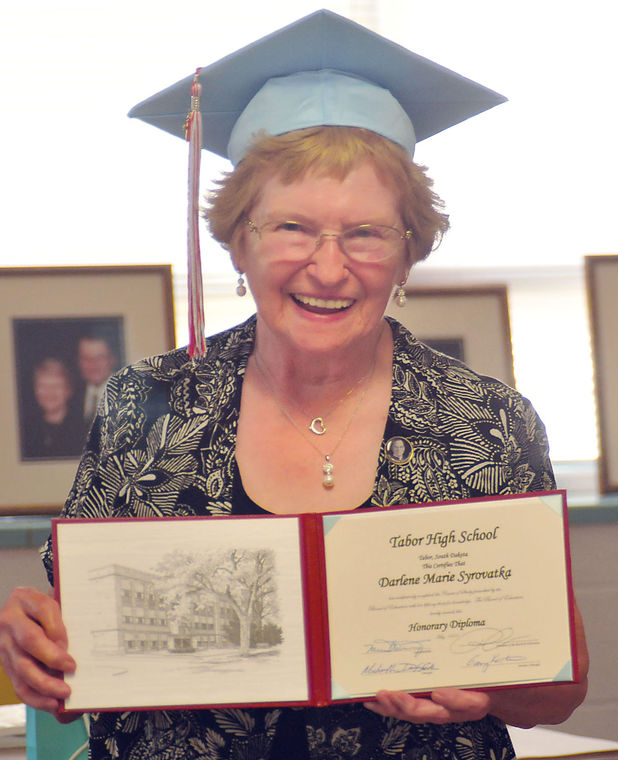
Darlene Marie (Syrovatka) Carda enjoyed all the traditions of high school graduation Monday night.
She wore the mortarboard, accepted her diploma and smiled for photos during the short ceremony at the Tabor elementary school. And yes, she celebrated afterwards with cake - even cutting it for guests.
She also proudly showed off her yearbook - the 1950 “Cardinal” from her freshman year in high school. For when it came to completing high school, she literally awaited a lifetime.
That’s because the Korean War got in the way of her high school plans. Carda and her fiancée decided to marry before he left for the military. They wed Jan. 8, 1952, when she was 16.
“We got married at St. Wenceslaus Church, just up the street,” she said. “Back then, when you got married, that was the end of school. But I considered marriage my vocation - marriage and having a family. I had 12 children, eight girls and four boys.”
Carda never returned to high school, but she never stopped learning. She took a number of courses, yet she always dreamed of getting her high school diploma.
That dream became reality Monday during a “graduation” ceremony held during the Bon Homme school board meeting in Tabor. Carda became an official Tabor High School graduate 63 years after her classmates took to the stage.
Carda received her honorary diploma as a member of the Class of 1953. She became the latest - and most likely the last - graduate of the Tabor school district, which no longer exists.
Tabor and Tyndall combined to form the Tyndall-Tabor district. The merged district later joined with Springfield to form the present-day Bon Homme school district.
The 63-year wait for the diploma was well worth it, Carda said.
“I can’t say enough. This is so exciting,” she said, beaming as she clutched the sheepskin. “I always dreamed of this, but I thought there was no way of doing it. To receive a diploma - I thought I had no more ability to do it than the man on the moon.”
Now 81 years old, Carda lives in Elkhorn, Nebraska, She celebrated her birthday May 28, with the diploma one of the best presents she could imagine.
Current Bon Homme Superintendent Mike Elsberry spent most of the past year corresponding with Carda’s daughter, Rebecca Leigh, about the possibility of a diploma.
“This has been nine months and millions of emails in the making,” Elsberry said with a laugh as he opened the commencement program.
Much has changed over the years, including the Tabor school’s location, Elsberry said. “I’m not sure she could find her old school,” he said.
The audience included family members from New York, Connecticut, Alaska and Omaha, Nebraska. Recognition was given to two of Carda’s classmates, Sharleen (Kaiser) Hovorka and Lumir Ruman, who were in attendance and posed with her for pictures.
Rebecca Leigh and her sister, Rachel Andrews, offered loving thoughts about their mother and her lifelong achievements.
Carda’s carefree high school days included classes, chorus, girls’ glee club, declamation, cheerleading and dances, Leigh said. Carda assumed she would graduate from high school, but those plans gave way to a totally different life’s path.
While she didn’t complete high school, Carda continued to educate herself. A voracious reader, she filled her home library with books from wall to wall and has read all of them.
In addition, Carda also attended Creighton University’s Lifelong Learning Center in Omaha. She has shown a particular interest in the subjects of marriage, physiology and positive thinking.
She has also deepened and learned more about the Bible and her Catholic faith. She has attended dozens of conferences and retreats in her pursuit of knowledge.
Carda has also mentored students at Boys Town in Omaha, where she has attended Mass for more than 30 years. In addition, she taught religious education classes for the Omaha Archdiocese.
She nearly died last October for a cerebral aneurysm, but she has resumed reading novels and has learned to use an iPhone for the first time. She makes extensive use of Face Time, Facebook, email, texting, photos and downloading a variety of word and math apps.
“She even learned how to use those cute little emojis,” Leigh said.
In addition, Carda maintained a journal for the past 30 years, compiling more than 3,000 pages of entries. Leigh hopes to make a book about her mother’s life. In one anecdote, a priest at Boys Town advised her that life is hard, but not to lose heart.
In much the same way, Carda didn’t lose heart about never receiving her diploma.
“This is something you thought was out of reach forever, but you did it!” Leigh told her mother. “You showed the importance of finishing what you started!”
Rachel Andrews shared another side of her mother that looked at the simple things of life. Carda stressed the importance of childhood lessons such as following the Golden Rule, enjoying cookies and milk followed by a nap, and holding hands and sticking together.
Pippa Leigh presented her grandmother with a Tiffany heart necklace, replacing one that Carda had lost.
Leigh thanked the Bon Homme district, particularly Elsberry, for arranging the diploma and graduation program.
Carda received congratulations when she walked through a receiving line of the Bon Homme school board members and administrators. She shared her thanks and presented her 1950 yearbook to the school district for its archives.
Bon Homme school board vice president Preston Crissey said holding the graduation ceremony meant a great deal to him.
“This is a special deal to be a part of,” he told the Press & Dakotan. “It shows you can complete your goals at any time of your life.”
Crissey pointed to the important life lessons provided by Carda and others of her generation. He also noted the importance of Carda’s achievement to her family, as members traveled hundreds and even thousands of miles for Monday night’s ceremony.
Bon Homme school board member Ben Hellmann agreed on the meaningfulness of the moment.
“This is awesome. These people (from her generation) sacrificed for things that we take for granted,” he said. “It’s amazing. She had 12 kids, and look at all she accomplished in her life.”
The close family bonds were apparent during Monday’s ceremony, Hellmann said.
“She had family members who came from as far away as Alaska,” he said. “But I also think things like this mean a lot in a small community.”
Carda provides a valuable life lesson, Elsberry said. “It shows the importance of finishing anything you start,” he said.
Carda expressed gratitude at all those who made Monday’s program a reality.
“I could have received this diploma in the mail, but it wasn’t what my children wanted,” she said. “They wanted me to have the experience of ‘walking down the aisle’ and receiving my diploma.”
Carda hopes others share her passion and thirst for knowledge, even if they do it in a non-traditional way.
“You should always be learning,” she said. “It’s something that should be continued throughout your lifetime. It’s all part of your life’s journey.”
Source: Yankton (South Dakota) Press & Dakotan, Randy Dockendorf ~ June 14, 2016
Dr. I. W. Leighton, a young man recently from Chicago, arrived Scotland Tuesday and has decided to located here. Dr. Leighton's home is in Iowa City, Ia., but he attended school at the Northwestern University in Chicago, having graduated from that institution in June, 1909. He then took work in the Illinois Postgraduate school, and spent several months in practice at St. Luke's hospital in Chicago. He then accepted a position as physician for a mining company near LaSalle, Ill., but after remaining there for a few weeks the mine was closed by a strike so he decided to come and seek a location. He has established his office in the Becker Block, having the rooms formerly occupied by Dr. Winkler, and has sent for his office fixtures which are now in Chicago. The doctor is a married man, his wife now being with her people in Chicago, where she will remain until he gets settled here and finds a suitable place in which to live. Dr. Leighton is a young man of good appearance, has had good professional training and we trust will find the field here satisfactory.
Source: The Citizen-Republican (Scotland, SD) ~ June 30, 1910
Tyndall Register: George Memmer, of Avon, was before the board of insanity Wednesday. He was adjudged insane. An attendant arrived from Yankton the evening freight and on Thursday morning the unfortunate young man was taken to the hospital for the insane.
Source: The Citizen-Republican (Scotland, SD) ~ June 21, 1906

In the Catholic world, there is no life without the sacraments. And there are no sacraments without priests. But while priests across the Archdiocese of Detroit bring those sacraments daily to their parishioners, their service goes well beyond that. They are comforters, friends, advisers, shepherds, leaders, listeners and sometimes even handymen. This year, 47 archdiocesan priests are celebrating milestone anniversaries of their priestly ordination, including three bishops who are featured earlier in this section. For all they do, and for their lifelong commitment to Christ’s flock, we say thanks and offer our prayers.
Fr. James Bjorum, 68, was born in Scotland, S.D., and attended Sacred Heart Seminary in Detroit, the University of Detroit and St. John’s Provincial Seminary in Plymouth Township. He also earned a master’s in canon law and canon law license from the University of St. Paul in Ottawa, Ontario.
He was ordained Feb. 7, 1976, and celebrated his first Mass at St. Matthew Church, Detroit.
Fr. Bjorum served as associate pastor at St. Anne Parish, Warren (1976-79); and St. Agatha Parish, Redford Township (1979-82). He served as a judge on the Metropolitan Tribunal from 1984-86, and from 1986-89 served as chaplain to Bishop Gallagher High School in Harper Woods. In 1988, he was named associate director of vocations for the archdiocese’s Northeast Region.
Fr. Bjorum became pastor of St. Germaine Parish in St. Clair Shores in 1989, serving there until the parish’s merger with nearby St. Gertrude Parish formed Our Lady of Hope Parish in 2009. Fr. Bjorum served as administrator of the new parish, and was assigned as its pastor in 2011. He remains there today.
Fr. Bjorum has also served as vicar of the SERF Vicariate (1992-95) and as a member of the archdiocesan Presbyteral Council (2003-05).
Source: The Michigan Catholic ~ July 12, 2016
In conversation with Ed H. Kunkel (Konkler/Kunkler) of Scotland, who had the misfortune of losing his wife some two weeks since and leaving three small children motherless, he informed us that he returned the latter part of the week from a trip to Mott, North Dakota, and on his return was accompanied by a sister of the deceased mother, in the person of Mrs. Stella Dill, of the last named place, and through her kindness the three little children will be given a good home and the best of care in the future.
Source: The Citizen-Republican (Scotland, SD) ~ May 23, 1918
When the county commissioners met last week they found W. J. W. Devers, who was turned over to the county authorities by his son and son-in-law, Dr. Fox of Parkston, to be sent to the insane asylum, still confined in the county jail. The commissioners looked into the matter and concluded that Mr. Devers was not a fit subject for the insane asylum, but was simply in need of the care of a faithful nurse. They therefore rented a comfortable room for him in Tyndall, hired a man to take came of him and gave instructions to give him all the comforts possible. Mr. Devers owns a good farm near Tyndall, which the records show is free from incumbrance, and the board has done the humane thing in providing him proper care, and his property will be holden for the expense.
Source: The Citizen-Republican (Scotland, SD) ~ October 15, 1908
Solomon Biem closed out the balance of his stock of goods at auction last Saturday, and left today with his family for Philadelphia. He is not yet decided as to his future location but will visit Philadelphia and at Egg Harbor, New Jersey, where her parents, Mr. and Mrs. Leveson, reside. Mr. Biem has been in Scotland for about nine years, and says he has done well financially, and likes the country and the people, but his wife wishes to locate nearer to her people so he has decided to make the change. We wish them success in their new home where ever they may decide to locate.
Source: The Citizen-Republican (Scotland, SD) ~ January 13, 1910
Last Saturday Deputy Sheriff W. E. Cobb was notified that Jim Hinek, a Bohemian farmer living about eight miles southwest of town, had gone insane and was tramping over his farm with a gun looking for parties whom he imagined were trying to kill him. W. E. and Chas. Cobb and toy Haynes went at once to the premises to capture the demented man. Fortunately when they arrived at the house they found Mr. Hinek asleep in the bedroom, a musket standing by his bed and a large knife lying on a table in easy reach. The weapons were secured, and the sleeping man was then awakened and with some difficulty was persuaded to accompany them to town, where he was placed in the city lock-up. It seems that last June Mr. Hinek's wife left him and has since secured a divorce with quite a large alimony, which compelled him to mortgage his farm. There were two children, a little girl who went with her mother, and a son about thirteen years of age who remained with his father. The trouble finally seems to have caused insanity and for three or for days he wandered about the place apparently seeking for his wife. The boy finally escaped to the home of a neighbor and explained the condition of his father, and he was taken into custody. He was declared insane by the board of insanity, but it seems that on account of the overcrowded condition of the asylum at Yankton they are unable to accommodate any more patients, and until some arrangements can be made he will remain in charge of Deputy Sheriff Cobb.
Source: The Citizen-Republican (Scotland, SD) ~ February 18, 1904
Hendrit Heida, a young Hollander who came to America last March and has been working on a farm near Tyndall, left last Thursday morning for his native land. Several weeks ago Mr. Heida received a telegram from Holland notifying him to return to be prepared to take up arms in defense of the country. For a time he was undecided what to do but on Wednesday of last week he received a letter from the mayor of his native town appealing to him to return. The letter fired the spark of patriotism in his breast and he decided to start for Holland without further delay.
Source: The Citizen-Republican (Scotland, SD) ~ September 3, 1914
